How to Use a Conceptual Framework for Better Research

A conceptual framework in research is not just a tool but a vital roadmap that guides the entire research process. It integrates various theories, assumptions, and beliefs to provide a structured approach to research. By defining a conceptual framework, researchers can focus their inquiries and clarify their hypotheses, leading to more effective and meaningful research outcomes.

What is a Conceptual Framework?
A conceptual framework is essentially an analytical tool that combines concepts and sets them within an appropriate theoretical structure. It serves as a lens through which researchers view the complexities of the real world. The importance of a conceptual framework lies in its ability to serve as a guide, helping researchers to not only visualize but also systematically approach their study.
Key Components and to be Analyzed During Research
- Theories: These are the underlying principles that guide the hypotheses and assumptions of the research.
- Assumptions: These are the accepted truths that are not tested within the scope of the research but are essential for framing the study.
- Beliefs: These often reflect the subjective viewpoints that may influence the interpretation of data.
- Ready to use
- Fully customizable template
- Get Started in seconds

Together, these components help to define the conceptual framework that directs the research towards its ultimate goal. This structured approach not only improves clarity but also enhances the validity and reliability of the research outcomes. By using a conceptual framework, researchers can avoid common pitfalls and focus on essential variables and relationships.
For practical examples and to see how different frameworks can be applied in various research scenarios, you can Explore Conceptual Framework Examples .
Different Types of Conceptual Frameworks Used in Research
Understanding the various types of conceptual frameworks is crucial for researchers aiming to align their studies with the most effective structure. Conceptual frameworks in research vary primarily between theoretical and operational frameworks, each serving distinct purposes and suiting different research methodologies.
Theoretical vs Operational Frameworks
Theoretical frameworks are built upon existing theories and literature, providing a broad and abstract understanding of the research topic. They help in forming the basis of the study by linking the research to already established scholarly works. On the other hand, operational frameworks are more practical, focusing on how the study’s theories will be tested through specific procedures and variables.
- Theoretical frameworks are ideal for exploratory studies and can help in understanding complex phenomena.
- Operational frameworks suit studies requiring precise measurement and data analysis.
Choosing the Right Framework
Selecting the appropriate conceptual framework is pivotal for the success of a research project. It involves matching the research questions with the framework that best addresses the methodological needs of the study. For instance, a theoretical framework might be chosen for studies that aim to generate new theories, while an operational framework would be better suited for testing specific hypotheses.
Benefits of choosing the right framework include enhanced clarity, better alignment with research goals, and improved validity of research outcomes. Tools like Table Chart Maker can be instrumental in visually comparing the strengths and weaknesses of different frameworks, aiding in this crucial decision-making process.
Real-World Examples of Conceptual Frameworks in Research
Understanding the practical application of conceptual frameworks in research can significantly enhance the clarity and effectiveness of your studies. Here, we explore several real-world case studies that demonstrate the pivotal role of conceptual frameworks in achieving robust research conclusions.
- Healthcare Research: In a study examining the impact of lifestyle choices on chronic diseases, researchers used a conceptual framework to link dietary habits, exercise, and genetic predispositions. This framework helped in identifying key variables and their interrelations, leading to more targeted interventions.
- Educational Development: Educational theorists often employ conceptual frameworks to explore the dynamics between teaching methods and student learning outcomes. One notable study mapped out the influences of digital tools on learning engagement, providing insights that shaped educational policies.
- Environmental Policy: Conceptual frameworks have been crucial in environmental research, particularly in studies on climate change adaptation. By framing the relationships between human activity, ecological changes, and policy responses, researchers have been able to propose more effective sustainability strategies.
Adapting conceptual frameworks based on evolving research data is also critical. As new information becomes available, it’s essential to revisit and adjust the framework to maintain its relevance and accuracy, ensuring that the research remains aligned with real-world conditions.
For those looking to visualize and better comprehend their research frameworks, Graphic Organizers for Conceptual Frameworks can be an invaluable tool. These organizers help in structuring and presenting research findings clearly, enhancing both the process and the presentation of your research.
Step-by-Step Guide to Creating Your Own Conceptual Framework
Creating a conceptual framework is a critical step in structuring your research to ensure clarity and focus. This guide will walk you through the process of building a robust framework, from identifying key concepts to refining your approach as your research evolves.
Building Blocks of a Conceptual Framework
- Identify and Define Main Concepts and Variables: Start by clearly identifying the main concepts, variables, and their relationships that will form the basis of your research. This could include defining key terms and establishing the scope of your study.
- Develop a Hypothesis or Primary Research Question: Formulate a central hypothesis or question that guides the direction of your research. This will serve as the foundation upon which your conceptual framework is built.
- Link Theories and Concepts Logically: Connect your identified concepts and variables with existing theories to create a coherent structure. This logical linking helps in forming a strong theoretical base for your research.
Visualizing and Refining Your Framework
Using visual tools can significantly enhance the clarity and effectiveness of your conceptual framework. Decision Tree Templates for Conceptual Frameworks can be particularly useful in mapping out the relationships between variables and hypotheses.
Map Your Framework: Utilize tools like Creately’s visual canvas to diagram your framework. This visual representation helps in identifying gaps or overlaps in your framework and provides a clear overview of your research structure.

Analyze and Refine: As your research progresses, continuously evaluate and refine your framework. Adjustments may be necessary as new data comes to light or as initial assumptions are challenged.
By following these steps, you can ensure that your conceptual framework is not only well-defined but also adaptable to the changing dynamics of your research.
Practical Tips for Utilizing Conceptual Frameworks in Research
Effectively utilizing a conceptual framework in research not only streamlines the process but also enhances the clarity and coherence of your findings. Here are some practical tips to maximize the use of conceptual frameworks in your research endeavors.
- Setting Clear Research Goals: Begin by defining precise objectives that are aligned with your research questions. This clarity will guide your entire research process, ensuring that every step you take is purposeful and directly contributes to your overall study aims. \
- Maintaining Focus and Coherence: Throughout the research, consistently refer back to your conceptual framework to maintain focus. This will help in keeping your research aligned with the initial goals and prevent deviations that could dilute the effectiveness of your findings.
- Data Analysis and Interpretation: Use your conceptual framework as a lens through which to view and interpret data. This approach ensures that the data analysis is not only systematic but also meaningful in the context of your research objectives. For more insights, explore Research Data Analysis Methods .
- Presenting Research Findings: When it comes time to present your findings, structure your presentation around the conceptual framework . This will help your audience understand the logical flow of your research and how each part contributes to the whole.
- Avoiding Common Pitfalls: Be vigilant about common errors such as overcomplicating the framework or misaligning the research methods with the framework’s structure. Keeping it simple and aligned ensures that the framework effectively supports your research.
By adhering to these tips and utilizing tools like 7 Essential Visual Tools for Social Work Assessment , researchers can ensure that their conceptual frameworks are not only robust but also practically applicable in their studies.
How Creately Enhances the Creation and Use of Conceptual Frameworks
Creating a robust conceptual framework is pivotal for effective research, and Creately’s suite of visual tools offers unparalleled support in this endeavor. By leveraging Creately’s features, researchers can visualize, organize, and analyze their research frameworks more efficiently.
- Visual Mapping of Research Plans: Creately’s infinite visual canvas allows researchers to map out their entire research plan visually. This helps in understanding the complex relationships between different research variables and theories, enhancing the clarity and effectiveness of the research process.
- Brainstorming with Mind Maps: Using Mind Mapping Software , researchers can generate and organize ideas dynamically. Creately’s intelligent formatting helps in brainstorming sessions, making it easier to explore multiple topics or delve deeply into specific concepts.
- Centralized Data Management: Creately enables the importation of data from multiple sources, which can be integrated into the visual research framework. This centralization aids in maintaining a cohesive and comprehensive overview of all research elements, ensuring that no critical information is overlooked.
- Communication and Collaboration: The platform supports real-time collaboration, allowing teams to work together seamlessly, regardless of their physical location. This feature is crucial for research teams spread across different geographies, facilitating effective communication and iterative feedback throughout the research process.
Moreover, the ability t Explore Conceptual Framework Examples directly within Creately inspires researchers by providing practical templates and examples that can be customized to suit specific research needs. This not only saves time but also enhances the quality of the conceptual framework developed.
In conclusion, Creately’s tools for creating and managing conceptual frameworks are indispensable for researchers aiming to achieve clear, structured, and impactful research outcomes.
Join over thousands of organizations that use Creately to brainstorm, plan, analyze, and execute their projects successfully.
More Related Articles

Chiraag George is a communication specialist here at Creately. He is a marketing junkie that is fascinated by how brands occupy consumer mind space. A lover of all things tech, he writes a lot about the intersection of technology, branding and culture at large.
- Link to facebook
- Link to linkedin
- Link to twitter
- Link to youtube
- Writing Tips
How to Make a Conceptual Framework

- 6-minute read
- 2nd January 2022
What is a conceptual framework? And why is it important?
A conceptual framework illustrates the relationship between the variables of a research question. It’s an outline of what you’d expect to find in a research project.
Conceptual frameworks should be constructed before data collection and are vital because they map out the actions needed in the study. This should be the first step of an undergraduate or graduate research project.
What Is In a Conceptual Framework?
In a conceptual framework, you’ll find a visual representation of the key concepts and relationships that are central to a research study or project . This can be in form of a diagram, flow chart, or any other visual representation. Overall, a conceptual framework serves as a guide for understanding the problem being studied and the methods being used to investigate it.
Steps to Developing the Perfect Conceptual Framework
- Pick a question
- Conduct a literature review
- Identify your variables
- Create your conceptual framework
1. Pick a Question
You should already have some idea of the broad area of your research project. Try to narrow down your research field to a manageable topic in terms of time and resources. From there, you need to formulate your research question. A research question answers the researcher’s query: “What do I want to know about my topic?” Research questions should be focused, concise, arguable and, ideally, should address a topic of importance within your field of research.
An example of a simple research question is: “What is the relationship between sunny days and ice cream sales?”
2. Conduct a Literature Review
A literature review is an analysis of the scholarly publications on a chosen topic. To undertake a literature review, search for articles with the same theme as your research question. Choose updated and relevant articles to analyze and use peer-reviewed and well-respected journals whenever possible.
For the above example, the literature review would investigate publications that discuss how ice cream sales are affected by the weather. The literature review should reveal the variables involved and any current hypotheses about this relationship.
3. Identify Your Variables
There are two key variables in every experiment: independent and dependent variables.
Independent Variables
The independent variable (otherwise known as the predictor or explanatory variable) is the expected cause of the experiment: what the scientist changes or changes on its own. In our example, the independent variable would be “the number of sunny days.”
Dependent Variables
The dependent variable (otherwise known as the response or outcome variable) is the expected effect of the experiment: what is being studied or measured. In our example, the dependent variable would be “the quantity of ice cream sold.”
Next, there are control variables.
Control Variables
A control variable is a variable that may impact the dependent variable but whose effects are not going to be measured in the research project. In our example, a control variable could be “the socioeconomic status of participants.” Control variables should be kept constant to isolate the effects of the other variables in the experiment.
Finally, there are intervening and extraneous variables.
Find this useful?
Subscribe to our newsletter and get writing tips from our editors straight to your inbox.
Intervening Variables
Intervening variables link the independent and dependent variables and clarify their connection. In our example, an intervening variable could be “temperature.”
Extraneous Variables
Extraneous variables are any variables that are not being investigated but could impact the outcomes of the study. Some instances of extraneous variables for our example would be “the average price of ice cream” or “the number of varieties of ice cream available.” If you control an extraneous variable, it becomes a control variable.
4. Create Your Conceptual Framework
Having picked your research question, undertaken a literature review, and identified the relevant variables, it’s now time to construct your conceptual framework. Conceptual frameworks are clear and often visual representations of the relationships between variables.
We’ll start with the basics: the independent and dependent variables.
Our hypothesis is that the quantity of ice cream sold directly depends on the number of sunny days; hence, there is a cause-and-effect relationship between the independent variable (the number of sunny days) and the dependent and independent variable (the quantity of ice cream sold).
Next, introduce a control variable. Remember, this is anything that might directly affect the dependent variable but is not being measured in the experiment:
Finally, introduce the intervening and extraneous variables.
The intervening variable (temperature) clarifies the relationship between the independent variable (the number of sunny days) and the dependent variable (the quantity of ice cream sold). Extraneous variables, such as the average price of ice cream, are variables that are not controlled and can potentially impact the dependent variable.
Are Conceptual Frameworks and Research Paradigms the Same?
In simple terms, the research paradigm is what informs your conceptual framework. In defining our research paradigm we ask the big questions—Is there an objective truth and how can we understand it? If we decide the answer is yes, we may be working with a positivist research paradigm and will choose to build a conceptual framework that displays the relationship between fixed variables. If not, we may be working with a constructivist research paradigm, and thus our conceptual framework will be more of a loose amalgamation of ideas, theories, and themes (a qualitative study). If this is confusing–don’t worry! We have an excellent blog post explaining research paradigms in more detail.
Where is the Conceptual Framework Located in a Thesis?
This will depend on your discipline, research type, and school’s guidelines, but most papers will include a section presenting the conceptual framework in the introduction, literature review, or opening chapter. It’s best to present your conceptual framework after presenting your research question, but before outlining your methodology.
Can a Conceptual Framework be Used in a Qualitative Study?
Yes. Despite being less clear-cut than a quantitative study, all studies should present some form of a conceptual framework. Let’s say you were doing a study on care home practices and happiness, and you came across a “happiness model” constructed by a relevant theorist in your literature review. Your conceptual framework could be an outline or a visual depiction of how you will use this model to collect and interpret qualitative data for your own study (such as interview responses). Check out this useful resource showing other examples of conceptual frameworks for qualitative studies .
Expert Proofreading for Researchers
Whether you’re a seasoned academic or not, you will want your research paper to be error-free and fluently written. That’s where proofreading comes in. Our editors are on hand 24 hours a day to ensure your writing is concise, clear, and precise. Submit a free sample of your writing today to try our services.
Share this article:
Post A New Comment
Got content that needs a quick turnaround? Let us polish your work. Explore our editorial business services.
9-minute read
How to Use Infographics to Boost Your Presentation
Is your content getting noticed? Capturing and maintaining an audience’s attention is a challenge when...
8-minute read
Why Interactive PDFs Are Better for Engagement
Are you looking to enhance engagement and captivate your audience through your professional documents? Interactive...
7-minute read
Seven Key Strategies for Voice Search Optimization
Voice search optimization is rapidly shaping the digital landscape, requiring content professionals to adapt their...
4-minute read
Five Creative Ways to Showcase Your Digital Portfolio
Are you a creative freelancer looking to make a lasting impression on potential clients or...
How to Ace Slack Messaging for Contractors and Freelancers
Effective professional communication is an important skill for contractors and freelancers navigating remote work environments....
3-minute read
How to Insert a Text Box in a Google Doc
Google Docs is a powerful collaborative tool, and mastering its features can significantly enhance your...

Make sure your writing is the best it can be with our expert English proofreading and editing.
Have a language expert improve your writing
Run a free plagiarism check in 10 minutes, automatically generate references for free.
- Knowledge Base
- Dissertation
What is a Theoretical Framework? | A Step-by-Step Guide
Published on 14 February 2020 by Shona McCombes . Revised on 10 October 2022.
A theoretical framework is a foundational review of existing theories that serves as a roadmap for developing the arguments you will use in your own work.
Theories are developed by researchers to explain phenomena, draw connections, and make predictions. In a theoretical framework, you explain the existing theories that support your research, showing that your work is grounded in established ideas.
In other words, your theoretical framework justifies and contextualises your later research, and it’s a crucial first step for your research paper , thesis, or dissertation . A well-rounded theoretical framework sets you up for success later on in your research and writing process.
Instantly correct all language mistakes in your text
Be assured that you'll submit flawless writing. Upload your document to correct all your mistakes.

Table of contents
Why do you need a theoretical framework, how to write a theoretical framework, structuring your theoretical framework, example of a theoretical framework, frequently asked questions about theoretical frameworks.
Before you start your own research, it’s crucial to familiarise yourself with the theories and models that other researchers have already developed. Your theoretical framework is your opportunity to present and explain what you’ve learned, situated within your future research topic.
There’s a good chance that many different theories about your topic already exist, especially if the topic is broad. In your theoretical framework, you will evaluate, compare, and select the most relevant ones.
By “framing” your research within a clearly defined field, you make the reader aware of the assumptions that inform your approach, showing the rationale behind your choices for later sections, like methodology and discussion . This part of your dissertation lays the foundations that will support your analysis, helping you interpret your results and make broader generalisations .
- In literature , a scholar using postmodernist literary theory would analyse The Great Gatsby differently than a scholar using Marxist literary theory.
- In psychology , a behaviourist approach to depression would involve different research methods and assumptions than a psychoanalytic approach.
- In economics , wealth inequality would be explained and interpreted differently based on a classical economics approach than based on a Keynesian economics one.
The only proofreading tool specialized in correcting academic writing
The academic proofreading tool has been trained on 1000s of academic texts and by native English editors. Making it the most accurate and reliable proofreading tool for students.

Correct my document today
To create your own theoretical framework, you can follow these three steps:
- Identifying your key concepts
- Evaluating and explaining relevant theories
- Showing how your research fits into existing research
1. Identify your key concepts
The first step is to pick out the key terms from your problem statement and research questions . Concepts often have multiple definitions, so your theoretical framework should also clearly define what you mean by each term.
To investigate this problem, you have identified and plan to focus on the following problem statement, objective, and research questions:
Problem : Many online customers do not return to make subsequent purchases.
Objective : To increase the quantity of return customers.
Research question : How can the satisfaction of company X’s online customers be improved in order to increase the quantity of return customers?
2. Evaluate and explain relevant theories
By conducting a thorough literature review , you can determine how other researchers have defined these key concepts and drawn connections between them. As you write your theoretical framework, your aim is to compare and critically evaluate the approaches that different authors have taken.
After discussing different models and theories, you can establish the definitions that best fit your research and justify why. You can even combine theories from different fields to build your own unique framework if this better suits your topic.
Make sure to at least briefly mention each of the most important theories related to your key concepts. If there is a well-established theory that you don’t want to apply to your own research, explain why it isn’t suitable for your purposes.
3. Show how your research fits into existing research
Apart from summarising and discussing existing theories, your theoretical framework should show how your project will make use of these ideas and take them a step further.
You might aim to do one or more of the following:
- Test whether a theory holds in a specific, previously unexamined context
- Use an existing theory as a basis for interpreting your results
- Critique or challenge a theory
- Combine different theories in a new or unique way
A theoretical framework can sometimes be integrated into a literature review chapter , but it can also be included as its own chapter or section in your dissertation. As a rule of thumb, if your research involves dealing with a lot of complex theories, it’s a good idea to include a separate theoretical framework chapter.
There are no fixed rules for structuring your theoretical framework, but it’s best to double-check with your department or institution to make sure they don’t have any formatting guidelines. The most important thing is to create a clear, logical structure. There are a few ways to do this:
- Draw on your research questions, structuring each section around a question or key concept
- Organise by theory cluster
- Organise by date
As in all other parts of your research paper , thesis, or dissertation , make sure to properly cite your sources to avoid plagiarism .
To get a sense of what this part of your thesis or dissertation might look like, take a look at our full example .
While a theoretical framework describes the theoretical underpinnings of your work based on existing research, a conceptual framework allows you to draw your own conclusions, mapping out the variables you may use in your study and the interplay between them.
A literature review and a theoretical framework are not the same thing and cannot be used interchangeably. While a theoretical framework describes the theoretical underpinnings of your work, a literature review critically evaluates existing research relating to your topic. You’ll likely need both in your dissertation .
A theoretical framework can sometimes be integrated into a literature review chapter , but it can also be included as its own chapter or section in your dissertation . As a rule of thumb, if your research involves dealing with a lot of complex theories, it’s a good idea to include a separate theoretical framework chapter.
A literature review is a survey of scholarly sources (such as books, journal articles, and theses) related to a specific topic or research question .
It is often written as part of a dissertation , thesis, research paper , or proposal .
Cite this Scribbr article
If you want to cite this source, you can copy and paste the citation or click the ‘Cite this Scribbr article’ button to automatically add the citation to our free Reference Generator.
McCombes, S. (2022, October 10). What is a Theoretical Framework? | A Step-by-Step Guide. Scribbr. Retrieved 14 May 2024, from https://www.scribbr.co.uk/thesis-dissertation/the-theoretical-framework/
Is this article helpful?
Shona McCombes
Other students also liked, what is a literature review | guide, template, & examples, how to write a results section | tips & examples, how to write a discussion section | tips & examples.
What is a good example of a conceptual framework?
Last updated
18 April 2023
Reviewed by
Miroslav Damyanov
A well-designed study doesn’t just happen. Researchers work hard to ensure the studies they conduct will be scientifically valid and will advance understanding in their field.
Make research less tedious
Dovetail streamlines research to help you uncover and share actionable insights
- The importance of a conceptual framework
The main purpose of a conceptual framework is to improve the quality of a research study. A conceptual framework achieves this by identifying important information about the topic and providing a clear roadmap for researchers to study it.
Through the process of developing this information, researchers will be able to improve the quality of their studies in a few key ways.
Clarify research goals and objectives
A conceptual framework helps researchers create a clear research goal. Research projects often become vague and lose their focus, which makes them less useful. However, a well-designed conceptual framework helps researchers maintain focus. It reinforces the project’s scope, ensuring it stays on track and produces meaningful results.
Provide a theoretical basis for the study
Forming a hypothesis requires knowledge of the key variables and their relationship to each other. Researchers need to identify these variables early on to create a conceptual framework. This ensures researchers have developed a strong understanding of the topic before finalizing the study design. It also helps them select the most appropriate research and analysis methods.
Guide the research design
As they develop their conceptual framework, researchers often uncover information that can help them further refine their work.
Here are some examples:
Confounding variables they hadn’t previously considered
Sources of bias they will have to take into account when designing the project
Whether or not the information they were going to study has already been covered—this allows them to pivot to a more meaningful goal that brings new and relevant information to their field
- Steps to develop a conceptual framework
There are four major steps researchers will follow to develop a conceptual framework. Each step will be described in detail in the sections that follow. You’ll also find examples of how each might be applied in a range of fields.
Step 1: Choose the research question
The first step in creating a conceptual framework is choosing a research question . The goal of this step is to create a question that’s specific and focused.
By developing a clear question, researchers can more easily identify the variables they will need to account for and keep their research focused. Without it, the next steps will be more difficult and less effective.
Here are some examples of good research questions in a few common fields:
Natural sciences: How does exposure to ultraviolet radiation affect the growth rate of a particular type of algae?
Health sciences: What is the effectiveness of cognitive-behavioral therapy for treating depression in adolescents?
Business: What factors contribute to the success of small businesses in a particular industry?
Education: How does implementing technology in the classroom impact student learning outcomes?
Step 2: Select the independent and dependent variables
Once the research question has been chosen, it’s time to identify the dependent and independent variables .
The independent variable is the variable researchers think will affect the dependent variable . Without this information, researchers cannot develop a meaningful hypothesis or design a way to test it.
The dependent and independent variables for our example questions above are:
Natural sciences
Independent variable: exposure to ultraviolet radiation
Dependent variable: the growth rate of a particular type of algae
Health sciences
Independent variable: cognitive-behavioral therapy
Dependent variable: depression in adolescents
Independent variables: factors contributing to the business’s success
Dependent variable: sales, return on investment (ROI), or another concrete metric
Independent variable: implementation of technology in the classroom
Dependent variable: student learning outcomes, such as test scores, GPAs, or exam results
Step 3: Visualize the cause-and-effect relationship
This step is where researchers actually develop their hypothesis. They will predict how the independent variable will impact the dependent variable based on their knowledge of the field and their intuition.
With a hypothesis formed, researchers can more accurately determine what data to collect and how to analyze it. They will then visualize their hypothesis by creating a diagram. This visualization will serve as a framework to help guide their research.
The diagrams for our examples might be used as follows:
Natural sciences : how exposure to radiation affects the biological processes in the algae that contribute to its growth rate
Health sciences : how different aspects of cognitive behavioral therapy can affect how patients experience symptoms of depression
Business : how factors such as market demand, managerial expertise, and financial resources influence a business’s success
Education : how different types of technology interact with different aspects of the learning process and alter student learning outcomes
Step 4: Identify other influencing variables
The independent and dependent variables are only part of the equation. Moderating, mediating, and control variables are also important parts of a well-designed study. These variables can impact the relationship between the two main variables and must be accounted for.
A moderating variable is one that can change how the independent variable affects the dependent variable. A mediating variable explains the relationship between the two. Control variables are kept the same to eliminate their impact on the results. Examples of each are given below:
Moderating variable: water temperature (might impact how algae respond to radiation exposure)
Mediating variable: chlorophyll production (might explain how radiation exposure affects algae growth rate)
Control variable: nutrient levels in the water
Moderating variable: the severity of depression symptoms at baseline might impact how effective the therapy is for different adolescents
Mediating variable: social support might explain how cognitive-behavioral therapy leads to improvements in depression
Control variable: other forms of treatment received before or during the study
Moderating variable: the size of the business (might impact how different factors contribute to market share, sales, ROI, and other key success metrics)
Mediating variable: customer satisfaction (might explain how different factors impact business success)
Control variable: industry competition
Moderating variable: student age (might impact how effective technology is for different students)
Mediating variable: teacher training (might explain how technology leads to improvements in learning outcomes)
Control variable: student learning style
- Conceptual versus theoretical frameworks
Although they sound similar, conceptual and theoretical frameworks have different goals and are used in different contexts. Understanding which to use will help researchers craft better studies.
Conceptual frameworks describe a broad overview of the subject and outline key concepts, variables, and the relationships between them. They provide structure to studies that are more exploratory in nature, where the relationships between the variables are still being established. They are particularly helpful in studies that are complex or interdisciplinary because they help researchers better organize the factors involved in the study.
Theoretical frameworks, on the other hand, are used when the research question is more clearly defined and there’s an existing body of work to draw upon. They define the relationships between the variables and help researchers predict outcomes. They are particularly helpful when researchers want to refine the existing body of knowledge rather than establish it.
Should you be using a customer insights hub?
Do you want to discover previous research faster?
Do you share your research findings with others?
Do you analyze research data?
Start for free today, add your research, and get to key insights faster
Editor’s picks
Last updated: 11 January 2024
Last updated: 15 January 2024
Last updated: 17 January 2024
Last updated: 12 May 2023
Last updated: 30 April 2024
Last updated: 18 May 2023
Last updated: 25 November 2023
Last updated: 13 May 2024
Latest articles
Related topics, .css-je19u9{-webkit-align-items:flex-end;-webkit-box-align:flex-end;-ms-flex-align:flex-end;align-items:flex-end;display:-webkit-box;display:-webkit-flex;display:-ms-flexbox;display:flex;-webkit-flex-direction:row;-ms-flex-direction:row;flex-direction:row;-webkit-box-flex-wrap:wrap;-webkit-flex-wrap:wrap;-ms-flex-wrap:wrap;flex-wrap:wrap;-webkit-box-pack:center;-ms-flex-pack:center;-webkit-justify-content:center;justify-content:center;row-gap:0;text-align:center;max-width:671px;}@media (max-width: 1079px){.css-je19u9{max-width:400px;}.css-je19u9>span{white-space:pre;}}@media (max-width: 799px){.css-je19u9{max-width:400px;}.css-je19u9>span{white-space:pre;}} decide what to .css-1kiodld{max-height:56px;display:-webkit-box;display:-webkit-flex;display:-ms-flexbox;display:flex;-webkit-align-items:center;-webkit-box-align:center;-ms-flex-align:center;align-items:center;}@media (max-width: 1079px){.css-1kiodld{display:none;}} build next, decide what to build next.

Users report unexpectedly high data usage, especially during streaming sessions.

Users find it hard to navigate from the home page to relevant playlists in the app.

It would be great to have a sleep timer feature, especially for bedtime listening.

I need better filters to find the songs or artists I’m looking for.
Log in or sign up
Get started for free
How To Make Conceptual Framework (With Examples and Templates)
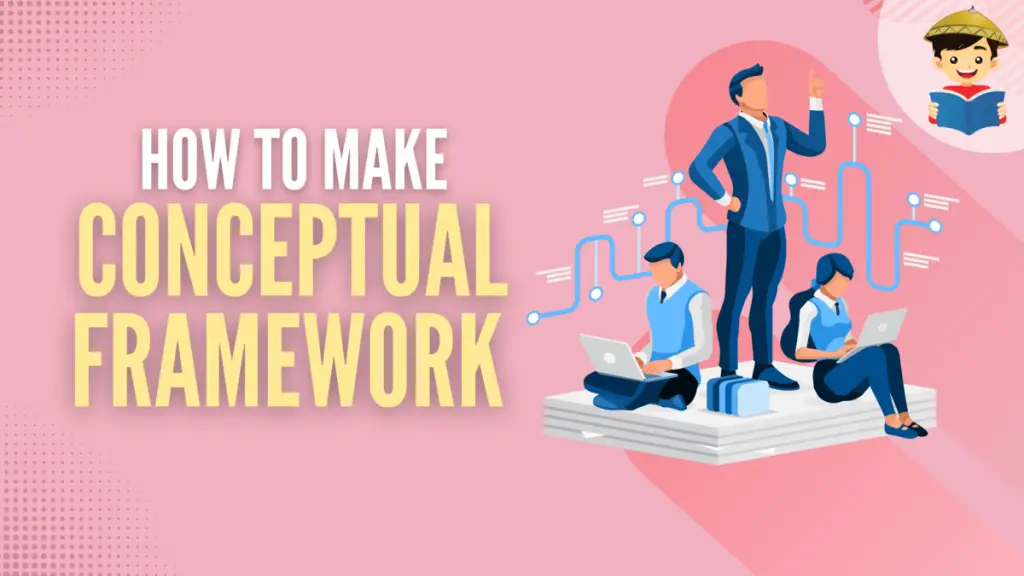
We all know that a research paper has plenty of concepts involved. However, a great deal of concepts makes your study confusing.
A conceptual framework ensures that the concepts of your study are organized and presented comprehensively. Let this article guide you on how to make the conceptual framework of your study.
Related: How to Write a Concept Paper for Academic Research
Table of Contents
At a glance: free conceptual framework templates.
Too busy to create a conceptual framework from scratch? No problem. We’ve created templates for each conceptual framework so you can start on the right foot. All you need to do is enter the details of the variables. Feel free to modify the design according to your needs. Please read the main article below to learn more about the conceptual framework.
Conceptual Framework Template #1: Independent-Dependent Variable Model
Conceptual framework template #2: input-process-output (ipo) model, conceptual framework template #3: concept map, what is a conceptual framework.
A conceptual framework shows the relationship between the variables of your study. It includes a visual diagram or a model that summarizes the concepts of your study and a narrative explanation of the model presented.
Why Should Research Be Given a Conceptual Framework?
Imagine your study as a long journey with the research result as the destination. You don’t want to get lost in your journey because of the complicated concepts. This is why you need to have a guide. The conceptual framework keeps you on track by presenting and simplifying the relationship between the variables. This is usually done through the use of illustrations that are supported by a written interpretation.
Also, people who will read your research must have a clear guide to the variables in your study and where the research is heading. By looking at the conceptual framework, the readers can get the gist of the research concepts without reading the entire study.
Related: How to Write Significance of the Study (with Examples)
What Is the Difference Between Conceptual Framework and Theoretical Framework?
Both of them show concepts and ideas of your study. The theoretical framework presents the theories, rules, and principles that serve as the basis of the research. Thus, the theoretical framework presents broad concepts related to your study. On the other hand, the conceptual framework shows a specific approach derived from the theoretical framework. It provides particular variables and shows how these variables are related.
Let’s say your research is about the Effects of Social Media on the Political Literacy of College Students. You may include some theories related to political literacy, such as this paper, in your theoretical framework. Based on this paper, political participation and awareness determine political literacy.
For the conceptual framework, you may state that the specific form of political participation and awareness you will use for the study is the engagement of college students on political issues on social media. Then, through a diagram and narrative explanation, you can show that using social media affects the political literacy of college students.
What Are the Different Types of Conceptual Frameworks?
The conceptual framework has different types based on how the research concepts are organized 1 .
1. Taxonomy
In this type of conceptual framework, the phenomena of your study are grouped into categories without presenting the relationship among them. The point of this conceptual framework is to distinguish the categories from one another.
2. Visual Presentation
In this conceptual framework, the relationship between the phenomena and variables of your study is presented. Using this conceptual framework implies that your research provides empirical evidence to prove the relationship between variables. This is the type of conceptual framework that is usually used in research studies.
3. Mathematical Description
In this conceptual framework, the relationship between phenomena and variables of your study is described using mathematical formulas. Also, the extent of the relationship between these variables is presented with specific quantities.
How To Make Conceptual Framework: 4 Steps
1. identify the important variables of your study.
There are two essential variables that you must identify in your study: the independent and the dependent variables.
An independent variable is a variable that you can manipulate. It can affect the dependent variable. Meanwhile, the dependent variable is the resulting variable that you are measuring.
You may refer to your research question to determine your research’s independent and dependent variables.
Suppose your research question is: “Is There a Significant Relationship Between the Quantity of Organic Fertilizer Used and the Plant’s Growth Rate?” The independent variable of this study is the quantity of organic fertilizer used, while the dependent variable is the plant’s growth rate.
2. Think About How the Variables Are Related
Usually, the variables of a study have a direct relationship. If a change in one of your variables leads to a corresponding change in another, they might have this kind of relationship.
However, note that having a direct relationship between variables does not mean they already have a cause-and-effect relationship 2 . It takes statistical analysis to prove causation between variables.
Using our example earlier, the quantity of organic fertilizer may directly relate to the plant’s growth rate. However, we are not sure that the quantity of organic fertilizer is the sole reason for the plant’s growth rate changes.
3. Analyze and Determine Other Influencing Variables
Consider analyzing if other variables can affect the relationship between your independent and dependent variables 3 .
4. Create a Visual Diagram or a Model
Now that you’ve identified the variables and their relationship, you may create a visual diagram summarizing them.
Usually, shapes such as rectangles, circles, and arrows are used for the model. You may create a visual diagram or model for your conceptual framework in different ways. The three most common models are the independent-dependent variable model, the input-process-output (IPO) model, and concept maps.
a. Using the Independent-Dependent Variable Model
You may create this model by writing the independent and dependent variables inside rectangles. Then, insert a line segment between them, connecting the rectangles. This line segment indicates the direct relationship between these variables.
Below is a visual diagram based on our example about the relationship between organic fertilizer and a plant’s growth rate.

b. Using the Input-Process-Output (IPO) Model
If you want to emphasize your research process, the input-process-output model is the appropriate visual diagram for your conceptual framework.
To create your visual diagram using the IPO model, follow these steps:
- Determine the inputs of your study . Inputs are the variables you will use to arrive at your research result. Usually, your independent variables are also the inputs of your research. Let’s say your research is about the Level of Satisfaction of College Students Using Google Classroom as an Online Learning Platform. You may include in your inputs the profile of your respondents and the curriculum used in the online learning platform.
- Outline your research process. Using our example above, the research process should be like this: Data collection of student profiles → Administering questionnaires → Tabulation of students’ responses → Statistical data analysis.
- State the research output . Indicate what you are expecting after you conduct the research. In our example above, the research output is the assessed level of satisfaction of college students with the use of Google Classroom as an online learning platform.
- Create the model using the research’s determined input, process, and output.
Presented below is the IPO model for our example above.

c. Using Concept Maps
If you think the two models presented previously are insufficient to summarize your study’s concepts, you may use a concept map for your visual diagram.
A concept map is a helpful visual diagram if multiple variables affect one another. Let’s say your research is about Coping with the Remote Learning System: Anxiety Levels of College Students. Presented below is the concept map for the research’s conceptual framework:
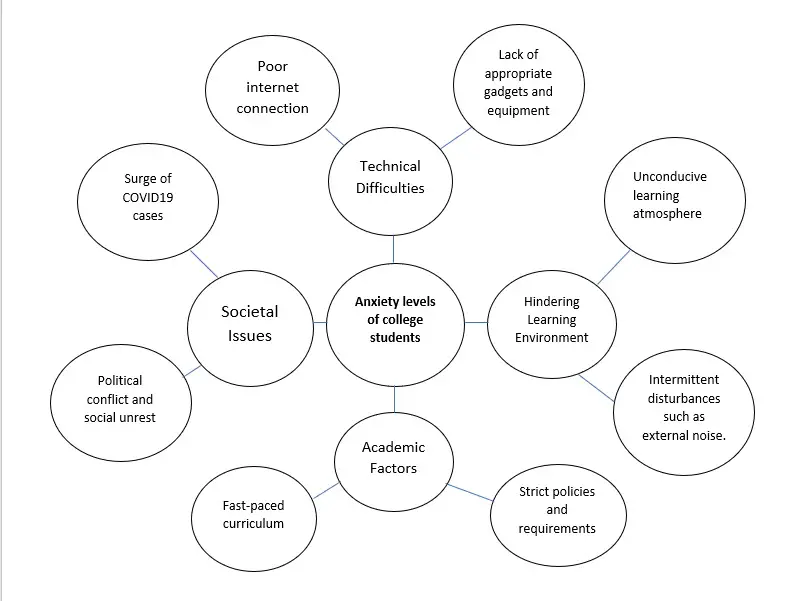
5. Explain Your Conceptual Framework in Narrative Form
Provide a brief explanation of your conceptual framework. State the essential variables, their relationship, and the research outcome.
Using the same example about the relationship between organic fertilizer and the growth rate of the plant, we can come up with the following explanation to accompany the conceptual framework:
Figure 1 shows the Conceptual Framework of the study. The quantity of the organic fertilizer used is the independent variable, while the plant’s growth is the research’s dependent variable. These two variables are directly related based on the research’s empirical evidence.
Conceptual Framework in Quantitative Research
You can create your conceptual framework by following the steps discussed in the previous section. Note, however, that quantitative research has statistical analysis. Thus, you may use arrows to indicate a cause-and-effect relationship in your model. An arrow implies that your independent variable caused the changes in your dependent variable.
Usually, for quantitative research, the Input-Process-Output model is used as a visual diagram. Here is an example of a conceptual framework in quantitative research:
Research Topic : Level of Effectiveness of Corn (Zea mays) Silk Ethanol Extract as an Antioxidant

Conceptual Framework in Qualitative Research
Again, you can follow the same step-by-step guide discussed previously to create a conceptual framework for qualitative research. However, note that you should avoid using one-way arrows as they may indicate causation . Qualitative research cannot prove causation since it uses only descriptive and narrative analysis to relate variables.
Here is an example of a conceptual framework in qualitative research:
Research Topic : Lived Experiences of Medical Health Workers During Community Quarantine
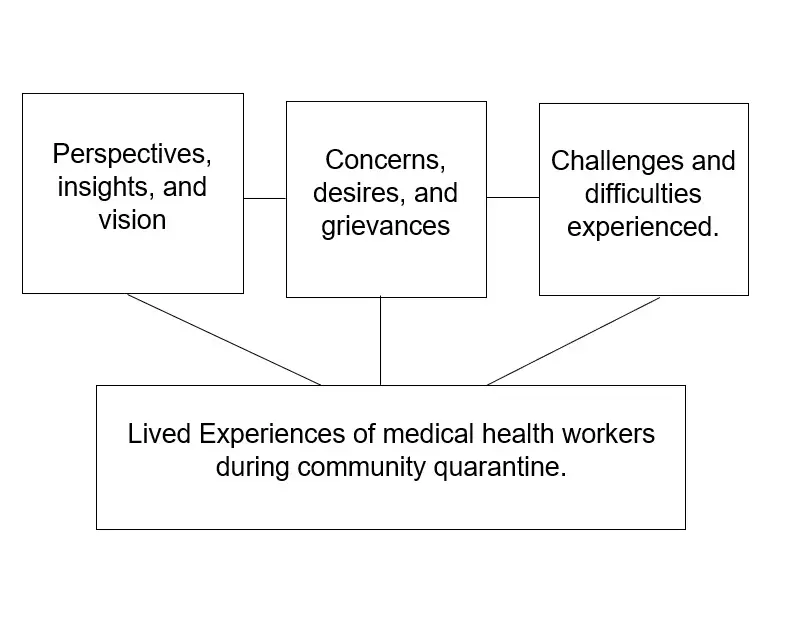
Conceptual Framework Examples
Presented below are some examples of conceptual frameworks.
Research Topic : Hypoglycemic Ability of Gabi (Colocasia esculenta) Leaf Extract in the Blood Glucose Level of Swiss Mice (Mus musculus)

Figure 1 presents the Conceptual Framework of the study. The quantity of gabi leaf extract is the independent variable, while the Swiss mice’s blood glucose level is the study’s dependent variable. This study establishes a direct relationship between these variables through empirical evidence and statistical analysis .
Research Topic : Level of Effectiveness of Using Social Media in the Political Literacy of College Students

Figure 1 shows the Conceptual Framework of the study. The input is the profile of the college students according to sex, year level, and the social media platform being used. The research process includes administering the questionnaires, tabulating students’ responses, and statistical data analysis and interpretation. The output is the effectiveness of using social media in the political literacy of college students.
Research Topic: Factors Affecting the Satisfaction Level of Community Inhabitants
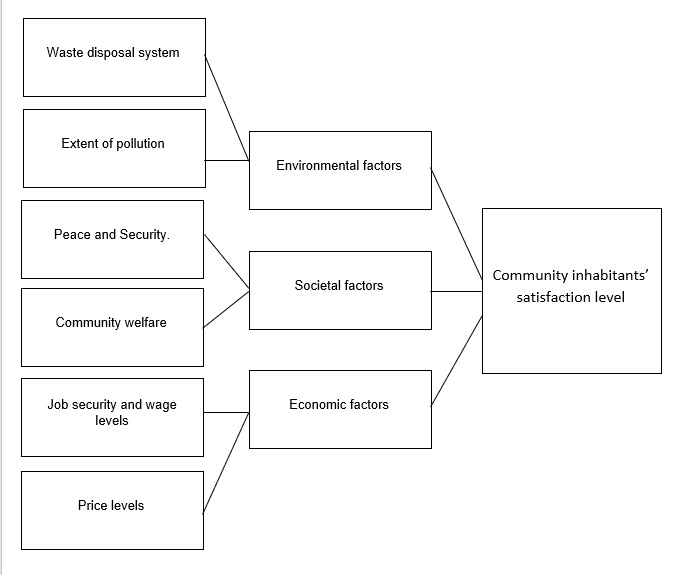
Figure 1 presents a visual illustration of the factors that affect the satisfaction level of community inhabitants. As presented, environmental, societal, and economic factors influence the satisfaction level of community inhabitants. Each factor has its indicators which are considered in this study.
Tips and Warnings
- Please keep it simple. Avoid using fancy illustrations or designs when creating your conceptual framework.
- Allot a lot of space for feedback. This is to show that your research variables or methodology might be revised based on the input from the research panel. Below is an example of a conceptual framework with a spot allotted for feedback.

Frequently Asked Questions
1. how can i create a conceptual framework in microsoft word.
First, click the Insert tab and select Shapes . You’ll see a wide range of shapes to choose from. Usually, rectangles, circles, and arrows are the shapes used for the conceptual framework.

Next, draw your selected shape in the document.
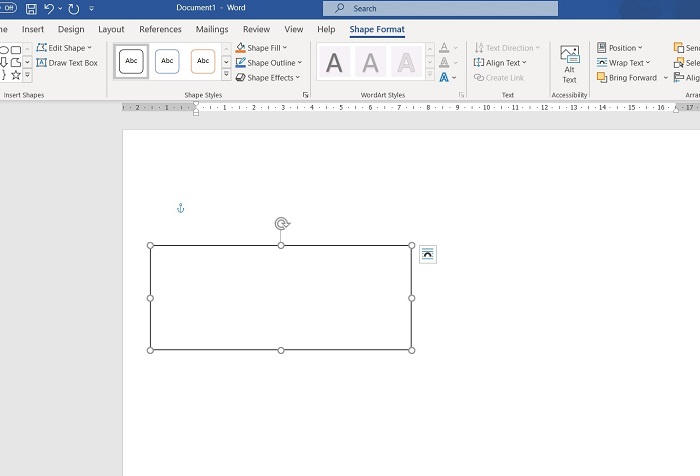
Insert the name of the variable inside the shape. You can do this by pointing your cursor to the shape, right-clicking your mouse, selecting Add Text , and typing in the text.
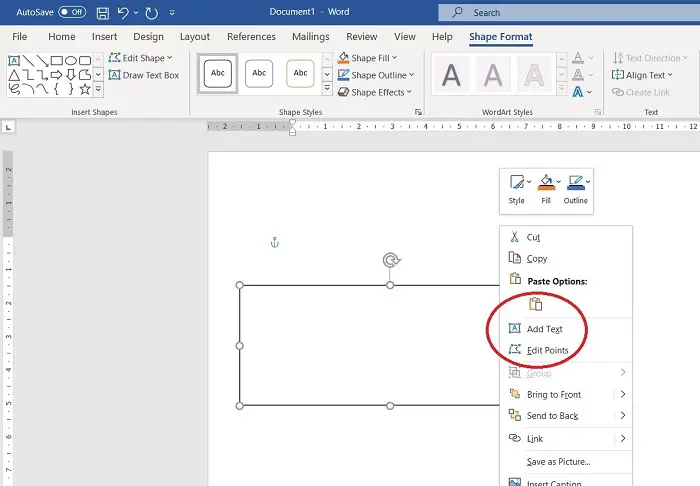
Repeat the same process for the remaining variables of your study. If you need arrows to connect the different variables, you can insert one by going to the Insert tab, then Shape, and finally, Lines or Block Arrows, depending on your preferred arrow style.

2. How to explain my conceptual framework in defense?
If you have used the Independent-Dependent Variable Model in creating your conceptual framework, start by telling your research’s variables. Afterward, explain the relationship between these variables. Example: “Using statistical/descriptive analysis of the data we have collected, we are going to show how the <state your independent variable> exhibits a significant relationship to <state your dependent variable>.”
On the other hand, if you have used an Input-Process-Output Model, start by explaining the inputs of your research. Then, tell them about your research process. You may refer to the Research Methodology in Chapter 3 to accurately present your research process. Lastly, explain what your research outcome is.
Meanwhile, if you have used a concept map, ensure you understand the idea behind the illustration. Discuss how the concepts are related and highlight the research outcome.
3. In what stage of research is the conceptual framework written?
The research study’s conceptual framework is in Chapter 2, following the Review of Related Literature.
4. What is the difference between a Conceptual Framework and Literature Review?
The Conceptual Framework is a summary of the concepts of your study where the relationship of the variables is presented. On the other hand, Literature Review is a collection of published studies and literature related to your study.
Suppose your research concerns the Hypoglycemic Ability of Gabi (Colocasia esculenta) Leaf Extract on Swiss Mice (Mus musculus). In your conceptual framework, you will create a visual diagram and a narrative explanation presenting the quantity of gabi leaf extract and the mice’s blood glucose level as your research variables. On the other hand, for the literature review, you may include this study and explain how this is related to your research topic.
5. When do I use a two-way arrow for my conceptual framework?
You will use a two-way arrow in your conceptual framework if the variables of your study are interdependent. If variable A affects variable B and variable B also affects variable A, you may use a two-way arrow to show that A and B affect each other.
Suppose your research concerns the Relationship Between Students’ Satisfaction Levels and Online Learning Platforms. Since students’ satisfaction level determines the online learning platform the school uses and vice versa, these variables have a direct relationship. Thus, you may use two-way arrows to indicate that the variables directly affect each other.
- Conceptual Framework – Meaning, Importance and How to Write it. (2020). Retrieved 27 April 2021, from https://afribary.com/knowledge/conceptual-framework/
- Correlation vs Causation. Retrieved 27 April 2021, from https://www.jmp.com/en_ph/statistics-knowledge-portal/what-is-correlation/correlation-vs-causation.html
- Swaen, B., & George, T. (2022, August 22). What is a conceptual framework? Tips & Examples. Retrieved December 5, 2022, from https://www.scribbr.com/methodology/conceptual-framework/
Written by Jewel Kyle Fabula
in Career and Education , Juander How
Jewel Kyle Fabula
Jewel Kyle Fabula is a Bachelor of Science in Economics student at the University of the Philippines Diliman. His passion for learning mathematics developed as he competed in some mathematics competitions during his Junior High School years. He loves cats, playing video games, and listening to music.
Browse all articles written by Jewel Kyle Fabula
Copyright Notice
All materials contained on this site are protected by the Republic of the Philippines copyright law and may not be reproduced, distributed, transmitted, displayed, published, or broadcast without the prior written permission of filipiknow.net or in the case of third party materials, the owner of that content. You may not alter or remove any trademark, copyright, or other notice from copies of the content. Be warned that we have already reported and helped terminate several websites and YouTube channels for blatantly stealing our content. If you wish to use filipiknow.net content for commercial purposes, such as for content syndication, etc., please contact us at legal(at)filipiknow(dot)net
- USC Libraries
- Research Guides
Organizing Your Social Sciences Research Paper
- Theoretical Framework
- Purpose of Guide
- Design Flaws to Avoid
- Independent and Dependent Variables
- Glossary of Research Terms
- Reading Research Effectively
- Narrowing a Topic Idea
- Broadening a Topic Idea
- Extending the Timeliness of a Topic Idea
- Academic Writing Style
- Applying Critical Thinking
- Choosing a Title
- Making an Outline
- Paragraph Development
- Research Process Video Series
- Executive Summary
- The C.A.R.S. Model
- Background Information
- The Research Problem/Question
- Citation Tracking
- Content Alert Services
- Evaluating Sources
- Primary Sources
- Secondary Sources
- Tiertiary Sources
- Scholarly vs. Popular Publications
- Qualitative Methods
- Quantitative Methods
- Insiderness
- Using Non-Textual Elements
- Limitations of the Study
- Common Grammar Mistakes
- Writing Concisely
- Avoiding Plagiarism
- Footnotes or Endnotes?
- Further Readings
- Generative AI and Writing
- USC Libraries Tutorials and Other Guides
- Bibliography
Theories are formulated to explain, predict, and understand phenomena and, in many cases, to challenge and extend existing knowledge within the limits of critical bounded assumptions or predictions of behavior. The theoretical framework is the structure that can hold or support a theory of a research study. The theoretical framework encompasses not just the theory, but the narrative explanation about how the researcher engages in using the theory and its underlying assumptions to investigate the research problem. It is the structure of your paper that summarizes concepts, ideas, and theories derived from prior research studies and which was synthesized in order to form a conceptual basis for your analysis and interpretation of meaning found within your research.
Abend, Gabriel. "The Meaning of Theory." Sociological Theory 26 (June 2008): 173–199; Kivunja, Charles. "Distinguishing between Theory, Theoretical Framework, and Conceptual Framework: A Systematic Review of Lessons from the Field." International Journal of Higher Education 7 (December 2018): 44-53; Swanson, Richard A. Theory Building in Applied Disciplines . San Francisco, CA: Berrett-Koehler Publishers 2013; Varpio, Lara, Elise Paradis, Sebastian Uijtdehaage, and Meredith Young. "The Distinctions between Theory, Theoretical Framework, and Conceptual Framework." Academic Medicine 95 (July 2020): 989-994.
Importance of Theory and a Theoretical Framework
Theories can be unfamiliar to the beginning researcher because they are rarely applied in high school social studies curriculum and, as a result, can come across as unfamiliar and imprecise when first introduced as part of a writing assignment. However, in their most simplified form, a theory is simply a set of assumptions or predictions about something you think will happen based on existing evidence and that can be tested to see if those outcomes turn out to be true. Of course, it is slightly more deliberate than that, therefore, summarized from Kivunja (2018, p. 46), here are the essential characteristics of a theory.
- It is logical and coherent
- It has clear definitions of terms or variables, and has boundary conditions [i.e., it is not an open-ended statement]
- It has a domain where it applies
- It has clearly described relationships among variables
- It describes, explains, and makes specific predictions
- It comprises of concepts, themes, principles, and constructs
- It must have been based on empirical data [i.e., it is not a guess]
- It must have made claims that are subject to testing, been tested and verified
- It must be clear and concise
- Its assertions or predictions must be different and better than those in existing theories
- Its predictions must be general enough to be applicable to and understood within multiple contexts
- Its assertions or predictions are relevant, and if applied as predicted, will result in the predicted outcome
- The assertions and predictions are not immutable, but subject to revision and improvement as researchers use the theory to make sense of phenomena
- Its concepts and principles explain what is going on and why
- Its concepts and principles are substantive enough to enable us to predict a future
Given these characteristics, a theory can best be understood as the foundation from which you investigate assumptions or predictions derived from previous studies about the research problem, but in a way that leads to new knowledge and understanding as well as, in some cases, discovering how to improve the relevance of the theory itself or to argue that the theory is outdated and a new theory needs to be formulated based on new evidence.
A theoretical framework consists of concepts and, together with their definitions and reference to relevant scholarly literature, existing theory that is used for your particular study. The theoretical framework must demonstrate an understanding of theories and concepts that are relevant to the topic of your research paper and that relate to the broader areas of knowledge being considered.
The theoretical framework is most often not something readily found within the literature . You must review course readings and pertinent research studies for theories and analytic models that are relevant to the research problem you are investigating. The selection of a theory should depend on its appropriateness, ease of application, and explanatory power.
The theoretical framework strengthens the study in the following ways :
- An explicit statement of theoretical assumptions permits the reader to evaluate them critically.
- The theoretical framework connects the researcher to existing knowledge. Guided by a relevant theory, you are given a basis for your hypotheses and choice of research methods.
- Articulating the theoretical assumptions of a research study forces you to address questions of why and how. It permits you to intellectually transition from simply describing a phenomenon you have observed to generalizing about various aspects of that phenomenon.
- Having a theory helps you identify the limits to those generalizations. A theoretical framework specifies which key variables influence a phenomenon of interest and highlights the need to examine how those key variables might differ and under what circumstances.
- The theoretical framework adds context around the theory itself based on how scholars had previously tested the theory in relation their overall research design [i.e., purpose of the study, methods of collecting data or information, methods of analysis, the time frame in which information is collected, study setting, and the methodological strategy used to conduct the research].
By virtue of its applicative nature, good theory in the social sciences is of value precisely because it fulfills one primary purpose: to explain the meaning, nature, and challenges associated with a phenomenon, often experienced but unexplained in the world in which we live, so that we may use that knowledge and understanding to act in more informed and effective ways.
The Conceptual Framework. College of Education. Alabama State University; Corvellec, Hervé, ed. What is Theory?: Answers from the Social and Cultural Sciences . Stockholm: Copenhagen Business School Press, 2013; Asher, Herbert B. Theory-Building and Data Analysis in the Social Sciences . Knoxville, TN: University of Tennessee Press, 1984; Drafting an Argument. Writing@CSU. Colorado State University; Kivunja, Charles. "Distinguishing between Theory, Theoretical Framework, and Conceptual Framework: A Systematic Review of Lessons from the Field." International Journal of Higher Education 7 (2018): 44-53; Omodan, Bunmi Isaiah. "A Model for Selecting Theoretical Framework through Epistemology of Research Paradigms." African Journal of Inter/Multidisciplinary Studies 4 (2022): 275-285; Ravitch, Sharon M. and Matthew Riggan. Reason and Rigor: How Conceptual Frameworks Guide Research . Second edition. Los Angeles, CA: SAGE, 2017; Trochim, William M.K. Philosophy of Research. Research Methods Knowledge Base. 2006; Jarvis, Peter. The Practitioner-Researcher. Developing Theory from Practice . San Francisco, CA: Jossey-Bass, 1999.
Strategies for Developing the Theoretical Framework
I. Developing the Framework
Here are some strategies to develop of an effective theoretical framework:
- Examine your thesis title and research problem . The research problem anchors your entire study and forms the basis from which you construct your theoretical framework.
- Brainstorm about what you consider to be the key variables in your research . Answer the question, "What factors contribute to the presumed effect?"
- Review related literature to find how scholars have addressed your research problem. Identify the assumptions from which the author(s) addressed the problem.
- List the constructs and variables that might be relevant to your study. Group these variables into independent and dependent categories.
- Review key social science theories that are introduced to you in your course readings and choose the theory that can best explain the relationships between the key variables in your study [note the Writing Tip on this page].
- Discuss the assumptions or propositions of this theory and point out their relevance to your research.
A theoretical framework is used to limit the scope of the relevant data by focusing on specific variables and defining the specific viewpoint [framework] that the researcher will take in analyzing and interpreting the data to be gathered. It also facilitates the understanding of concepts and variables according to given definitions and builds new knowledge by validating or challenging theoretical assumptions.
II. Purpose
Think of theories as the conceptual basis for understanding, analyzing, and designing ways to investigate relationships within social systems. To that end, the following roles served by a theory can help guide the development of your framework.
- Means by which new research data can be interpreted and coded for future use,
- Response to new problems that have no previously identified solutions strategy,
- Means for identifying and defining research problems,
- Means for prescribing or evaluating solutions to research problems,
- Ways of discerning certain facts among the accumulated knowledge that are important and which facts are not,
- Means of giving old data new interpretations and new meaning,
- Means by which to identify important new issues and prescribe the most critical research questions that need to be answered to maximize understanding of the issue,
- Means of providing members of a professional discipline with a common language and a frame of reference for defining the boundaries of their profession, and
- Means to guide and inform research so that it can, in turn, guide research efforts and improve professional practice.
Adapted from: Torraco, R. J. “Theory-Building Research Methods.” In Swanson R. A. and E. F. Holton III , editors. Human Resource Development Handbook: Linking Research and Practice . (San Francisco, CA: Berrett-Koehler, 1997): pp. 114-137; Jacard, James and Jacob Jacoby. Theory Construction and Model-Building Skills: A Practical Guide for Social Scientists . New York: Guilford, 2010; Ravitch, Sharon M. and Matthew Riggan. Reason and Rigor: How Conceptual Frameworks Guide Research . Second edition. Los Angeles, CA: SAGE, 2017; Sutton, Robert I. and Barry M. Staw. “What Theory is Not.” Administrative Science Quarterly 40 (September 1995): 371-384.
Structure and Writing Style
The theoretical framework may be rooted in a specific theory , in which case, your work is expected to test the validity of that existing theory in relation to specific events, issues, or phenomena. Many social science research papers fit into this rubric. For example, Peripheral Realism Theory, which categorizes perceived differences among nation-states as those that give orders, those that obey, and those that rebel, could be used as a means for understanding conflicted relationships among countries in Africa. A test of this theory could be the following: Does Peripheral Realism Theory help explain intra-state actions, such as, the disputed split between southern and northern Sudan that led to the creation of two nations?
However, you may not always be asked by your professor to test a specific theory in your paper, but to develop your own framework from which your analysis of the research problem is derived . Based upon the above example, it is perhaps easiest to understand the nature and function of a theoretical framework if it is viewed as an answer to two basic questions:
- What is the research problem/question? [e.g., "How should the individual and the state relate during periods of conflict?"]
- Why is your approach a feasible solution? [i.e., justify the application of your choice of a particular theory and explain why alternative constructs were rejected. I could choose instead to test Instrumentalist or Circumstantialists models developed among ethnic conflict theorists that rely upon socio-economic-political factors to explain individual-state relations and to apply this theoretical model to periods of war between nations].
The answers to these questions come from a thorough review of the literature and your course readings [summarized and analyzed in the next section of your paper] and the gaps in the research that emerge from the review process. With this in mind, a complete theoretical framework will likely not emerge until after you have completed a thorough review of the literature .
Just as a research problem in your paper requires contextualization and background information, a theory requires a framework for understanding its application to the topic being investigated. When writing and revising this part of your research paper, keep in mind the following:
- Clearly describe the framework, concepts, models, or specific theories that underpin your study . This includes noting who the key theorists are in the field who have conducted research on the problem you are investigating and, when necessary, the historical context that supports the formulation of that theory. This latter element is particularly important if the theory is relatively unknown or it is borrowed from another discipline.
- Position your theoretical framework within a broader context of related frameworks, concepts, models, or theories . As noted in the example above, there will likely be several concepts, theories, or models that can be used to help develop a framework for understanding the research problem. Therefore, note why the theory you've chosen is the appropriate one.
- The present tense is used when writing about theory. Although the past tense can be used to describe the history of a theory or the role of key theorists, the construction of your theoretical framework is happening now.
- You should make your theoretical assumptions as explicit as possible . Later, your discussion of methodology should be linked back to this theoretical framework.
- Don’t just take what the theory says as a given! Reality is never accurately represented in such a simplistic way; if you imply that it can be, you fundamentally distort a reader's ability to understand the findings that emerge. Given this, always note the limitations of the theoretical framework you've chosen [i.e., what parts of the research problem require further investigation because the theory inadequately explains a certain phenomena].
The Conceptual Framework. College of Education. Alabama State University; Conceptual Framework: What Do You Think is Going On? College of Engineering. University of Michigan; Drafting an Argument. Writing@CSU. Colorado State University; Lynham, Susan A. “The General Method of Theory-Building Research in Applied Disciplines.” Advances in Developing Human Resources 4 (August 2002): 221-241; Tavallaei, Mehdi and Mansor Abu Talib. "A General Perspective on the Role of Theory in Qualitative Research." Journal of International Social Research 3 (Spring 2010); Ravitch, Sharon M. and Matthew Riggan. Reason and Rigor: How Conceptual Frameworks Guide Research . Second edition. Los Angeles, CA: SAGE, 2017; Reyes, Victoria. Demystifying the Journal Article. Inside Higher Education; Trochim, William M.K. Philosophy of Research. Research Methods Knowledge Base. 2006; Weick, Karl E. “The Work of Theorizing.” In Theorizing in Social Science: The Context of Discovery . Richard Swedberg, editor. (Stanford, CA: Stanford University Press, 2014), pp. 177-194.
Writing Tip
Borrowing Theoretical Constructs from Other Disciplines
An increasingly important trend in the social and behavioral sciences is to think about and attempt to understand research problems from an interdisciplinary perspective. One way to do this is to not rely exclusively on the theories developed within your particular discipline, but to think about how an issue might be informed by theories developed in other disciplines. For example, if you are a political science student studying the rhetorical strategies used by female incumbents in state legislature campaigns, theories about the use of language could be derived, not only from political science, but linguistics, communication studies, philosophy, psychology, and, in this particular case, feminist studies. Building theoretical frameworks based on the postulates and hypotheses developed in other disciplinary contexts can be both enlightening and an effective way to be more engaged in the research topic.
CohenMiller, A. S. and P. Elizabeth Pate. "A Model for Developing Interdisciplinary Research Theoretical Frameworks." The Qualitative Researcher 24 (2019): 1211-1226; Frodeman, Robert. The Oxford Handbook of Interdisciplinarity . New York: Oxford University Press, 2010.
Another Writing Tip
Don't Undertheorize!
Do not leave the theory hanging out there in the introduction never to be mentioned again. Undertheorizing weakens your paper. The theoretical framework you describe should guide your study throughout the paper. Be sure to always connect theory to the review of pertinent literature and to explain in the discussion part of your paper how the theoretical framework you chose supports analysis of the research problem or, if appropriate, how the theoretical framework was found to be inadequate in explaining the phenomenon you were investigating. In that case, don't be afraid to propose your own theory based on your findings.
Yet Another Writing Tip
What's a Theory? What's a Hypothesis?
The terms theory and hypothesis are often used interchangeably in newspapers and popular magazines and in non-academic settings. However, the difference between theory and hypothesis in scholarly research is important, particularly when using an experimental design. A theory is a well-established principle that has been developed to explain some aspect of the natural world. Theories arise from repeated observation and testing and incorporates facts, laws, predictions, and tested assumptions that are widely accepted [e.g., rational choice theory; grounded theory; critical race theory].
A hypothesis is a specific, testable prediction about what you expect to happen in your study. For example, an experiment designed to look at the relationship between study habits and test anxiety might have a hypothesis that states, "We predict that students with better study habits will suffer less test anxiety." Unless your study is exploratory in nature, your hypothesis should always explain what you expect to happen during the course of your research.
The key distinctions are:
- A theory predicts events in a broad, general context; a hypothesis makes a specific prediction about a specified set of circumstances.
- A theory has been extensively tested and is generally accepted among a set of scholars; a hypothesis is a speculative guess that has yet to be tested.
Cherry, Kendra. Introduction to Research Methods: Theory and Hypothesis. About.com Psychology; Gezae, Michael et al. Welcome Presentation on Hypothesis. Slideshare presentation.
Still Yet Another Writing Tip
Be Prepared to Challenge the Validity of an Existing Theory
Theories are meant to be tested and their underlying assumptions challenged; they are not rigid or intransigent, but are meant to set forth general principles for explaining phenomena or predicting outcomes. Given this, testing theoretical assumptions is an important way that knowledge in any discipline develops and grows. If you're asked to apply an existing theory to a research problem, the analysis will likely include the expectation by your professor that you should offer modifications to the theory based on your research findings.
Indications that theoretical assumptions may need to be modified can include the following:
- Your findings suggest that the theory does not explain or account for current conditions or circumstances or the passage of time,
- The study reveals a finding that is incompatible with what the theory attempts to explain or predict, or
- Your analysis reveals that the theory overly generalizes behaviors or actions without taking into consideration specific factors revealed from your analysis [e.g., factors related to culture, nationality, history, gender, ethnicity, age, geographic location, legal norms or customs , religion, social class, socioeconomic status, etc.].
Philipsen, Kristian. "Theory Building: Using Abductive Search Strategies." In Collaborative Research Design: Working with Business for Meaningful Findings . Per Vagn Freytag and Louise Young, editors. (Singapore: Springer Nature, 2018), pp. 45-71; Shepherd, Dean A. and Roy Suddaby. "Theory Building: A Review and Integration." Journal of Management 43 (2017): 59-86.
- << Previous: The Research Problem/Question
- Next: 5. The Literature Review >>
- Last Updated: May 15, 2024 9:53 AM
- URL: https://libguides.usc.edu/writingguide
Conceptual Framework: A Step-by-Step Guide on How to Make One
What is a conceptual framework? How do you prepare one? This article defines the conceptual framework and lists the steps on how to prepare it. A simplified example is added to strengthen the reader’s understanding.
In preparing your research paper as one requirement for your course as an undergraduate or graduate student, you will need to write the conceptual framework of your study. The conceptual framework steers the whole research activity. The conceptual framework serves as a “map” or “rudder” that will guide you towards realizing your study’s objectives or intent.
What, then, is a conceptual framework in empirical research? The next section defines and explains the term.
Table of Contents
Definition of conceptual framework.
A conceptual framework represents the researcher’s synthesis of the literature on how to explain a phenomenon. It maps out the actions required in the study’s course, given the researcher’s previous knowledge of other researchers’ point of view and his or her observations about the phenomenon studied.
The conceptual framework is the researcher’s understanding of how the particular variables in the study connect. Thus, it identifies the variables required in the research investigation. It is the researcher’s “map” in pursuing the investigation.
As McGaghie et al . (2001) put it: The conceptual framework “sets the stage” to present the particular research question that drives the investigation being reported based on the problem statement. The problem statement of a thesis gives the context and the issues that caused the researcher to conduct the study.
The conceptual framework lies within a much broader framework called a theoretical framework . The latter draws support from time-tested theories that embody many researchers’ findings on why and how a particular phenomenon occurs.
I expounded on this definition, including its purpose, in my recent post titled “ What is a Conceptual Framework? Expounded Definition and Five Purposes .”
4 Steps on How to Make the Conceptual Framework
Before you prepare your conceptual framework, you need to do the following things:
Choose your topic
Decide on what will be your research topic. The topic should be within your field of specialization. (Generate your research topic using brainstorming tips ).
Do a literature review
Review relevant and updated research on the theme that you decide to work on after scrutiny of the issue at hand. Preferably use peer-reviewed , and well-known scientific journals as these are reliable sources of information.
Isolate the important variables
Identify the specific variables described in the literature and figure out how these are related. Some research abstracts contain the variables, and the salient findings thus may serve the purpose. If these are not available, find the research paper’s summary.
If the variables are not explicit in summary, get back to the methodology or the results and discussion section and quickly identify the study variables and the significant findings. Read the TSPU Technique to skim articles efficiently and get to the essential points with little fuss.
Generate the conceptual framework
Build your conceptual framework using your mix of the variables from the scientific articles you have read. Your problem statement or research objective serves as a reference for constructing it. In effect, your study will attempt to answer the question that other researchers have not explained yet. Your research should address a knowledge gap .
Example of a Conceptual Framework
Research topic.
Statement number 5 introduced in an earlier post titled How to Write a Thesis Statement will serve as the basis of the illustrated conceptual framework in the following examples.
The youth, particularly students who need to devote a lot of time using their mobile phones to access their course modules, laptops, or desktops, are most affected. Also, they spend time interacting with their mobile phones as they communicate with their friends on social media channels like Facebook, Messenger, and the like.
When free from schoolwork, many students spend their time viewing films on Netflix, YouTube, or similar sites. These activities can affect their sleeping patterns and cause health problems in the long run because light-emitting diode (LED) exposure reduces the number of hours spent sleeping.
Thesis Statement
Related to the students’ activity, we can write the thesis statement thus:
Thesis statement : Chronic exposure to blue light from LED screens (of computer monitors , mobile phones, tablets, and television) deplete melatonin levels, thus reducing the number of sleeping hours among the youth, particularly students who need to work on their academic requirements.
Review of Literature
The literature review supports the thesis statement as among those that catch one’s attention is a paper that warns against the use of LED devices at night. Although we can save a lot of electrical energy by using the efficient LED where the inventors Isamu Akasaki, Hiroshi Amano and Shuji Nakamura received a Nobel prize in physics in 2014, there is growing evidence that it can cause human health problems, particularly cancer.
Haim & Zubidat (2015) of the Israeli Center for Interdisciplinary Research in Chronobiology synthesized the literature about LEDs. They found out that blue light from the light-emitting diodes (LED) inhibits melatonin production, particularly during active secretion at night. Melatonin is a neuro-hormone that regulates sleep and wake cycles. Also, it can slow down aging and prevent cancer (Srinivasan et al., 2011).
Thus, looking directly at your laptop, mobile phone, or television at night not only can severely damage your eyes but also prevent the achievement of sound sleeping patterns. As a countermeasure, sleep experts recommend limiting the use of digital devices until 8 o’clock in the evening.
Those affected experience insomnia (see 10 Creative Ways on How to Get Rid of Insomnia ); they sleep less than required (usually less than six hours), and this happens when they spend too much time working on their laptops doing some machine learning stuff, monitoring conversations or posts on social media sites using their mobile phones, or viewing the television at night.
Variables Isolated from the Literature
Using the background information backed by evidence in the literature review, we can now develop the study’s paradigm on the effect of LED exposure to sleep. We will not include all the variables mentioned and select or isolate only those factors that we are interested in.
Figure 1 presents a visual representation, the paradigm, of what we want to correlate in this study. It shows measurable variables that can produce data we can analyze using a statistical test such as either the parametric test Pearson’s Product-Moment Correlation or the nonparametric test Spearman Rho (please refresh if you cannot see the figure).

Notice that the variables of the study are explicit in the paradigm presented in Figure 1. In the illustration, the two variables are:
1) the number of hours devoted in front of the computer, and 2) the number of hours slept through the night until dawn.
The former is the independent variable, while the latter is the dependent variable. Both variables are easy to measure. It is just counting the number of hours spent in front of the computer and the number of hours slept through the night in the study subjects.
Assuming that other things are constant during the study’s performance, it will be possible to relate these two variables and confirm that, indeed, blue light emanated from computer screens can affect one’s sleeping patterns. (Please read the article titled “ Do you know that the computer can disturb your sleeping patterns ?” to find out more about this phenomenon). A correlation analysis will show if the relationship is significant.
Related Reading :
- How the conceptual framework guides marketing research
Evolution of a Social Theory as Basis of Conceptual Framework Development
Related to the development of the conceptual framework, I wrote a comprehensive article on how a social theory develops by incisively looking at current events that the world is facing now — the COVID-19 pandemic. It shows how society responds to a threat to its very survival.
Specifically, this article focuses on the COVID-19 vaccine, how it develops and gets integrated into the complex fabric of human society. It shows how the development of the vaccine is only part of the story. A major consideration in its development resides in the supporters of the vaccine’s development, the government, and the recipients’ trust, thus the final acceptance of the vaccine.
Social theory serves as the backdrop or theoretical framework of the more focused or variable level conceptual framework. Hence, the paradigm that I develop at the end of that article can serve as a lens to examine how the three players of vaccine development interact more closely at the variable level. It shows the dynamics of power and social structure and how it unfolds in response to a pandemic that affects everyone.
Check out the article titled “ Pfizer COVID-19 Vaccine: More Than 90% Effective Against the Coronavirus .” This article shall enrich your knowledge of how an abstract concept narrows down into blocks of researchable topics.
Haim, A., & Zubidat, A. E. (2015). LED light between Nobel Prize and cancer risk factor. Chronobiology International , 32 (5), 725-727.
McGaghie, W. C.; Bordage, G.; and J. A. Shea (2001). Problem Statement, Conceptual Framework, and Research Question. Retrieved on January 5, 2015 from http://goo.gl/qLIUFg
Srinivasan, V., R Pandi-Perumal, S., Brzezinski, A., P Bhatnagar, K., & P Cardinali, D. (2011). Melatonin, immune function and cancer. Recent patents on endocrine, metabolic & immune drug discovery , 5 (2), 109-123.
©2015 January 5 P. A. Regoniel
Cite as: Regoniel, P. A. (2015, January 5). Conceptual framework: a step-by-step guide on how to make one. Research-based Articles. https://simplyeducate.me/wordpress_Y/2015/01/05/conceptual-framework-guide/
Related Posts
4 tips on how to take pictures useful in your research, 5 examples of psychology research topics related to climate change.

Chi-Square Test Example Computation and Practical Application
About the author, patrick regoniel.
Dr. Regoniel, a faculty member of the graduate school, served as consultant to various environmental research and development projects covering issues and concerns on climate change, coral reef resources and management, economic valuation of environmental and natural resources, mining, and waste management and pollution. He has extensive experience on applied statistics, systems modelling and analysis, an avid practitioner of LaTeX, and a multidisciplinary web developer. He leverages pioneering AI-powered content creation tools to produce unique and comprehensive articles in this website.
104 Comments
hallo! I would like to study “the socio-economic and environmental Impact of urban forests on livelihood: The perception of urban residents” how can my conceptual framework be like?
Hello Jesse, there are many free alternatives online if you are diligent enough in finding them. The reason I wrote this article is that in 2015, when I originally wrote it, I could not find an easy-to-understand explanation of the conceptual framework which will help my students. I also have a vague knowledge of the concept at that time, even with the available literature. Hence, I painstakingly gathered all materials I could from online and offline literature, synthesized them, and wrote about the concept in the simplest way I could without losing the essence. Now, I have seen many articles and even videos using the ideas I have rigorously prepared. If you find the tedious work I did irrelevant, then perhaps the ebook is expensive notwithstanding the many expenses on hosting, domain name, time and effort in maintaining the site that I incur in keeping this website online and make this ebook available to everyone.
I read the article how still struggling to come up with a conceptual framework, may you please assist, how should I go about as a new researcher my topic; INVESTIGATE THE DECISION TO TRANSFER NINE (9) FUNCTIONS OF ENVIRONMENTAL HEALTH TO LOCAL GOVERNMENT . Purpose: The purpose of this research is to review the delivery of EHS at the local government with a view to understanding the variation in performance and their causes. questions are: 1.2.1 What factors explain the performance variation in the delivery of EHS across municipalities? 1.2.2 How has devolution of the EH function aided or harmed the delivery of EHS?
Hello Mr. Siyabonga. I think what you want to find out is how environmental health services (EHS) performed at the local government level. In doing so, you need to have a set of indicators of successful transition. How is performance assessed? Once you already have a measure of success, then you need to define which variables in the local government have significantly influenced performance. After you have done so, then you can try to correlate local government characteristics and their performance.
I hope that helps.
My name is Jobson, my research topic is: The scope of Ugandan nurses and midwives in using the nursing process in the care of patients
our topic is Neutrophil and Lymphocyte Ratio as a Diagnostic Biomarker for Kidney Stones (experimental) How do I come up with a conceptual framework? What would be the variables?
My topic: E-commerce Platform for Agricultural and Construction Supplies with e-KYC Identification, Feed Page, and Products Bidding Will you please help me to make Conceptual Framework written with visual representation. thank you so much in advance.
Good day Jomar, I am not so clear about what you want to do. Can you write the objectives of your study? You can read about framing the research objectives here: https://simplyeducate.me/wordpress_Y/2020/03/15/research-objective/
My topic is; Mitigating against Childmaltreatment in earlychildhood through positive parenting: Chronicles of first time parents in XYZ City”
How do I come up with a conceptual framework? What would be variables?
Hello Phathi, Apparently, you are trying to relate parenting and child behavior?
Assessing the use of Geographic Information Systems (GIS) as a storage information tool in estate management:
How do i come up with a conceptual framework. What would be variables??
Dear Mbuso, Why will you assess the GIS use in estate management? What is it for?
SimplyEducate.Me Privacy Policy
Home » Feature » How to Make a Conceptual Framework (with Samples)
How to Make a Conceptual Framework (with Samples)
In this article, you will learn everything you need to know about conceptual frameworks, from what they are to how to make your own. Whether you are a novice or an experienced researcher, this article is for you. And by the end of this article, you will have a better understanding of scientific literature and a better grasp of conceptual frameworks.
What is a conceptual framework?
Research is an academic activity that necessitates a significant amount of abstraction or the creation of concepts or ideas in your mind about everything in your surroundings. This activity immerses you in a variety of higher-order thinking processes such as interpretation, criticism, application, and creation at all levels. Research, as a result of mental conceptions and evaluated holistically, must appear understandable to those who are eager to study the research findings. Because of the cognitive character of this scholarly academic task known as research, you will need a specific scheme, thorough plan, or system to describe the components of the research, including the relationships of the research elements.
You must create a conceptual framework for your study if you want to explain the ins and outs of your research in a nutshell. A conceptual framework is a graphical representation of your conceptions or ideas about the fundamental structure or components of your research, as well as the interactions between these pieces. It is a graph or non-prose material, specifically a schematic diagram that depicts well-ordered research elements. A conceptual framework is a comprehensive overview or strategy that gives meaning to your research by providing a well-planned arrangement of the components of your investigation.
Conceptual frameworks, on the other hand, are not usually necessary to be published in scientific publications. Even the average person can make their own. True scientific and authoritative examples, on the other hand, are often found in scientific journals. Furthermore, conceptual frameworks are not created at random by academics. They perform extensive literature evaluations to support their conceptual frameworks, ultimately increasing conceptual framework legitimacy.
Purposes of a Conceptual Framework
The conceptual framework illustrates the organization, sequence, and purpose of your research. It is a crucial first step in your research because a schematic diagram, which is also discussed vocally, enables readers to have a general understanding of your work. It describes the research activities you want to conduct, the manner in which you intend to conduct these activities, and the knowledge you possess to demonstrate your expertise with your study topic or research challenge. In a research study, it also serves the goal of illustrating the concepts and their interrelationship.
How to Make a Conceptual Framework?
Before you prepare your conceptual framework, you need to do the following things:
1. Choose your topic
As a researcher, you have the option of focusing on a wide range of topics. However, we must remember that not all of the world’s resources are available to us. The research could also be time-limited. It is therefore important to select a topic that can be completed within the time and resources available.
2. Make your research question
The research question, on the other hand, must be narrowly focused. All of the specifics must be laid out in a clear and concise manner. To put it simply, this is where your conceptual framework comes into play. For your research, you need to come up with a clear and reasonable question. This question should be one you’re really interested in to have a concise conceptual framework.
An important part of your conceptual framework and research is the development of a question that will guide your investigation. As a result, you won’t get lost while writing the paper.
3. Conduct a review of the literature
A review of literature is a process in which a researcher examines previously published work on a particular subject from reputable sources. You and your readers will benefit from a literature review if it reveals the current state of knowledge on your chosen topic, including its strengths and weaknesses. When conducting a literature review, keep in mind that it should be relevant to the topic under consideration, synthesize the findings of the publications you have read, and identify any areas in which additional information or evidence is needed to support the claim under consideration. Having a review of the literature narrows down what you will be putting in your conceptual framework.
4. Choose your variables
Since you have done your research, by this time, you will already be able to identify and pinpoint the variable that has been discussed in the publications you have studied and try to make a connection or decipher how they are linked. As you must have already read a lot of literature, you will find many possible variables to choose from when conducting your study. However, when creating research in general, it is vital that you only select the essential variables as not all of them will be significant; as you must have read much scientific literature, you should be able to discern the important ones by this point. And when creating a conceptual framework in particular, even though you can choose all the variables in the world, it would be best not to since too many variables in a conceptual framework will be confusing. It is also not a good idea to choose too few variables, or else your study might be too simple. As mentioned in the previous step, you have to find the right level of intricacy in your research that will fit your resources and time allocation.
5. Choose your relationships
Now that you have chosen your variables, you have to decide how these variables are related to one another. Given that you have already read much literature on your topic, you should already define how each of your variables is connected. This is especially important to note as this will largely impact how your conceptual framework will look once you start making the diagram.
6. Create the conceptual framework
Now that you have achieved all the previous steps, the final step is to illustrate the diagram. How you demonstrate the diagram will differ on a case-to-case basis. Still, variable names have to be laid out clearly and put into rectangles, variables have to be connected with lines and arrows, and the arrowheads will differ depending on the nature of the relationships. Single-head arrows are for one-directional relationships (i.e. A affects B and B does not affect A), and double-headed arrows are for relationships that are 2-directional (i.e. A affects B and B also affects A). Also, lines do not have to be limited to connecting only 2 variables (i.e. A and B); some relationships can be between more variables (i.e. A affects B and also C).
Tips for Writing a Conceptual Framework
- Familiarize yourself with the objective of the conceptual framework.
- Create the conceptual framework based on your own knowledge of the components and their interrelationships.
- Make sure that everything in the conceptual framework relates back to the study’s stated goals.
- Share your conceptual framework with others to solicit feedback and suggestions for development.
Conceptual Framework Examples
To have a clearer idea of the process of making a conceptual framework, let us try to make concrete examples of it.
Background: I am a co-owner of a branch of Burger King.
I am interested to know what affects the satisfaction of our customers. My goal is to know what specific parts of our business can influence our customers’ experience.
The research question I can formulate is “What affects customer satisfaction of Burger King?
I read up on different publications related to food establishments, specifically burger joints, and customer satisfaction. From here, I can already have an idea of the variables I can pinpoint from those publications that have been proven to affect customer satisfaction.
With all the books, scholarly articles, and research I have gone through, it can be determined that there are three main variables: food taste, speed of service, and staff performance. Customers are very much concerned with the taste of the product. The amount of time it takes to serve them also affects how pleased or displeased they are. Lastly, the performance of the staff that serves also affects their experience.
I was able to determine that the three variables: food taste, speed of service, and staff performance, are determining factors of customer satisfaction.
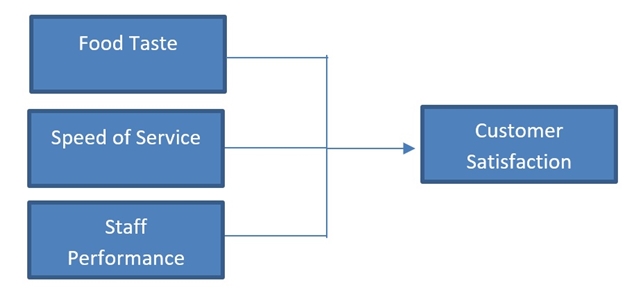
Research Problem of Topic : “Improving Critical Thinking through Systemic Functional Grammar”
Systemic Functional Grammar or SFG is a modern language theory that states that man’s critical thinking increases whenever he uses language for these reasons: first, for ideational function or for knowledge acquisition; second, for interpersonal function or creating human relationships, and third, for textual functions or for strategic and coherent expression of ideas, In this case, the independent variables are the SFG components (ideational, interpersonal, and textual functions) and the dependent variable is critical thinking. Here is the conceptual framework to present the concepts underlying this study. (Ravich & Riggan 2012)
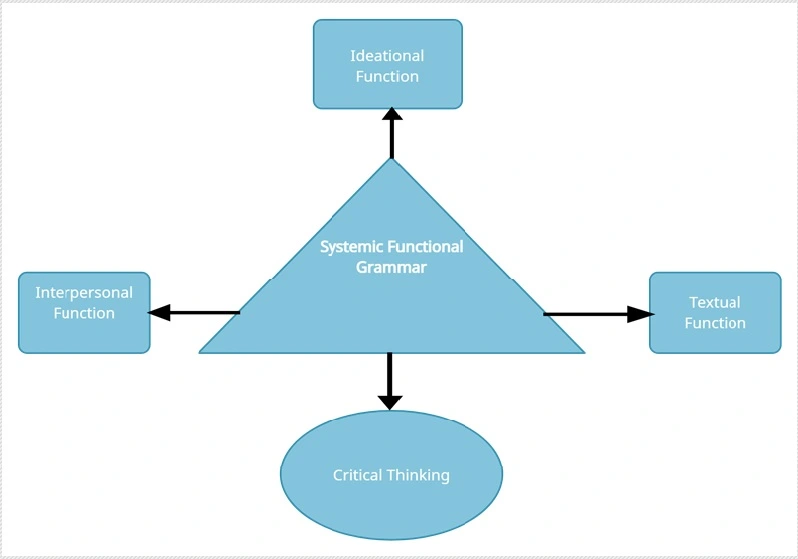
Conceptual Framework vs Theoretical Framework
The conceptual framework shows and illustrates all of your plans, concepts, or ideas regarding the various aspects of your research both graphically and verbally. However, the conceptual framework does not fully and completely explain all of the study’s elements, both concrete and abstract, when seen in such a broad or numerous manner. The theoretical framework, which is a separate section of your research paper, provides and discusses the theories, principles, generalizations, and research findings that are related to your research topic.
The conceptual framework gives readers a clear mental image of the fundamental organization of the study, the relationships between variables, and other relevant facts. Theoretical framework, on the other hand, helps individuals comprehend the relationships between the many research elements and the evidence-based truths, concepts, theories, and assumptions that support each part of the study.
The ability to think clearly and accurately about the many different aspects of your study is facilitated by having a thorough understanding of the theoretical principles governing or controlling those things. As a result, you have a better understanding of both the central issues in your research as well as its other elements. The theoretical framework provides the theoretical underpinnings of the research, while the conceptual framework provides a general sketch of how the research will be conducted using theories, principles, or generalizations that have been supported by facts and logical reasoning.
how do I create a conceptual framework for Logistics management performance and customer service satisfaction
After 1000’s of search trying to understand conceptual frame, your explanations made it so easy for me. Thank you for this useful work put together
thank you for providing such important idea and now i would like to ask one question let my research paper has five chapters so in which chapter will I include my conceptual framework?
Interesting reading
Very useful explanation. Got a point
- Civil Service Exam Reviewer
- L TO Portal Registration Guide
- How to Renew a Driver's License
- National ID Tracker
- Civil Service Exam Application
- Privacy Policy
- Terms of Service
All content provided on this website is for informational purposes only. The owner of this website makes no representations as to the accuracy or completeness of any information on this site or found by following any link on this site. The owner will not be liable for any errors or omissions in this information or for the availability of this information. The owner will not be liable for any losses, injuries, or damages from the display or use of this information.
You may not use the content of this blog for commercial purposes without prior formal written consent from us. These terms and conditions of use are subject to change at any time and without notice.
TOPNOTCHER PH is a participant in the Shopee Affiliate Program, an affiliate advertising program designed to provide a means for us to earn advertising fees by linking to SHOPEE.PH. As a Shopee Affiliate, we earn from your qualifying purchases through our links without extra cost to you.
© 2024 TOPNOTCHER.PH
- Chapter 1: Home
- Narrowing Your Topic
- Problem Statement
- Purpose Statement
- Conceptual Framework
Designing the Theoretical Framework
Theoretical framework guide, making a theoretical framework, example framework, additional framework resources.
- Quantitative Research Questions This link opens in a new window
- Qualitative Research Questions This link opens in a new window
- Qualitative & Quantitative Research Support with the ASC This link opens in a new window
- Library Research Consultations This link opens in a new window
What is it?
- A foundational review of existing theories.
- Serves as a roadmap or blueprint for developing arguments and supporting research.
- Overview of the theory that the research is based on.
- Can be made up of theories, principles, and concepts.
What does it do?
- Explains the why and how of a particular phenomenon within a particular body of literature.
- Connects the research subject with the theory.
- Specifies the study’s scope; makes it more valuable and generalizable.
- Guides further actions like framing the research questions, developing the literature review, and data collection and analyses.
What should be in it?
- Theory or theories that the researcher considers relevant for their research, principles, and concepts.
- Theoretical Framework Guide Use this guide to determine the guiding framework for your theoretical dissertation research.
How to make a theoretical framework
- Specify research objectives.
- Note the prominent variables under the study.
- Explore and review the literature through keywords identified as prominent variables.
- Note the theories that contain these variables or the keywords.
- Review all selected theories again in the light of the study’s objectives, and the key variables identified.
- Search for alternative theoretical propositions in the literature that may challenge the ones already selected.
- Ensure that the framework aligns with the study’s objectives, problem statement, the main research question, methodology, data analysis, and the expected conclusion.
- Decide on the final framework and begin developing.
- Theoretical Framework Example for a Thesis or Dissertation This link offers an example theoretical framework.
Some additional helpful resources in constructing a theoretical framework for study:
- https://www.scribbr.com/dissertation/theoretical-framework/
- https://www.scribbr.com/dissertation/theoretical-framework-example/
- https://www.projectguru.in/how-to-write-the-theoretical-framework-of-research/
Theoretical Framework Research
The term conceptual framework and theoretical framework are often and erroneously used interchangeably (Grant & Osanloo, 2014). A theoretical framework provides the theoretical assumptions for the larger context of a study, and is the foundation or ‘lens’ by which a study is developed. This framework helps to ground the research focus understudy within theoretical underpinnings and to frame the inquiry for data analysis and interpretation. The application of theory in traditional theoretical research is to understand, explain, and predict phenomena (Swanson, 2013).
Casanave, C.P.,& Li,Y.(2015). Novices’ struggles with conceptual and theoretical framing in writing dissertations and papers for publication. Publications,3 (2),104-119.doi:10.3390/publications3020104
Grant, C., & Osanloo, A. (2014). Understanding, Selecting, and Integrating a Theoretical Framework in Dissertation Research: Creating the Blueprint for Your “House. ” Administrative Issues Journal: Connecting Education, Practice, and Research, 4(2), 12–26
Swanson, R. (2013). Theory building in applied disciplines . San Francisco: Berrett-Koehler Publishers.
- << Previous: Conceptual Framework
- Next: Quantitative Research Questions >>
- Last Updated: Apr 24, 2024 2:48 PM
- URL: https://resources.nu.edu/c.php?g=1006886

- Coronavirus Updates
- Education at MUSC
- Adult Patient Care
- Hollings Cancer Center
- Children's Health
Biomedical Research
- Research Matters Blog
- NIH Peer Review
NIH announces the Simplified Framework for Peer Review

The mission of NIH is to seek fundamental knowledge about the nature and behavior of living systems and to apply that knowledge to enhance health, lengthen life, and reduce illness and disability . In support of this mission, Research Project Grant (RPG) applications to support biomedical and behavioral research are evaluated for scientific and technical merit through the NIH peer review system.
The Simplified Framework for NIH Peer Review initiative reorganizes the five regulatory criteria (Significance, Investigators, Innovation, Approach, Environment; 42 C.F.R. Part 52h.8 ) into three factors – two will receive numerical criterion scores and one will be evaluated for sufficiency. All three factors will be considered in determining the overall impact score. The reframing of the criteria serves to focus reviewers on three central questions they should be evaluating: 1) how important is the proposed research? 2) how rigorous and feasible are the methods? 3) do the investigators and institution have the expertise/resources necessary to carry out the project?
• Factor 1: Importance of the Research (Significance, Innovation), scored 1-9
• Factor 2: Rigor and Feasibility (Approach), scored 1-9
• Factor 3: Expertise and Resources (Investigator, Environment), to be evaluated with a selection from a drop-down menu
o Appropriate (no written explanation needed)
o Identify need for additional expertise and/or resources (requires reviewer to briefly address specific gaps in expertise or resources needed to carry out the project)
Simplifying Review of Research Project Grant Applications
NIH Activity Codes Affected by the Simplified Review Framework.
R01, R03, R15, R16, R21, R33, R34, R36, R61, RC1, RC2, RC4, RF1, RL1, RL2, U01, U34, U3R, UA5, UC1, UC2, UC4, UF1, UG3, UH2, UH3, UH5, (including the following phased awards: R21/R33, UH2/UH3, UG3/UH3, R61/R33).
Changes Coming to NIH Applications and Peer Review in 2025
• Simplified Review Framework for Most Research Project Grants (RPGs )
• Revisions to the NIH Fellowship Application and Review Process
• Updates to NRSA Training Grant Applications (under development)
• Updated Application Forms and Instructions
• Common Forms for Biographical Sketch and Current and Pending (Other) Support (coming soon)
Webinars, Notices, and Resources
Apr 17, 2024 - NIH Simplified Review Framework for Research Project Grants (RPG): Implementation and Impact on Funding Opportunities Webinar Recording & Resources
Nov 3, 2023 - NIH's Simplified Peer Review Framework for NIH Research Project Grant (RPG) Applications: for Applicants and Reviewers Webinar Recording & Resources
Oct 19, 2023 - Online Briefing on NIH’s Simplified Peer Review Framework for NIH Research Project Grant (RPG) Applications: for Applicants and Reviewers. See NOT-OD-24-010
Simplifying Review FAQs
Upcoming Webinars
Learn more and ask questions at the following upcoming webinars:
June 5, 2024 : Webinar on Updates to NIH Training Grant Applications (registration open)
September 19, 2024 : Webinar on Revisions to the Fellowship Application and Review Pro
Categories: NIH Policies , Research Education , Science Communications
METHODS article
This article is part of the research topic.
Toward Sustainable Futures: Optimizing Building Energy Consumption for a Greener Built Environment
Optimizing Office Building Operations: A Framework for Continuous Dynamic Energy Simulations in Decision-Making for Efficiency Provisionally Accepted

- 1 Riga Technical University, Latvia
- 2 Lafivents Ltd, Latvia
The final, formatted version of the article will be published soon.
Digital twins represent a promising approach for sustainable building operations and management in the context of the carbon neutrality goals of the European Union (EU). Using OpenStudio, an opensource platform for building energy modeling, we demonstrated the creation and editing of building digital twins. OpenStudio provides a user-friendly interface and extensive simulation capabilities, allowing detailed and accurate modeling of building components and systems. Using OpenStudio Measures, users can automate tasks and customize simulation models to optimize the building performance. The process of creating a building digital twin involves collecting historical data and accurately representing the building geometry; materials; schedules; and heating, ventilation, and air conditioning (HVAC) systems. Challenges such as data availability and model accuracy highlight the importance of modeling practices. Editing the digital twin involves modifying the OpenStudio model files and EnergyPlus weather files to simulate different building operation scenarios. Python programming language opportunities were considered for digital twin file modification. The potential of digital twins lies in their ability to simulate future building conditions and optimize building system settings. By integrating digital twins with machine learning algorithms and connecting them directly to building management systems, optimal building control strategies can be automated, thereby reducing energy consumption and improving occupant comfort levels.
Keywords: Natural ventilated buildings, Office building, Vents, Air exchange, tack effect, Energy simulations, retrofitting
Received: 22 Mar 2024; Accepted: 10 May 2024.
Copyright: © 2024 BORODINECS, Palcikovskis, Krumins and Lebedeva. This is an open-access article distributed under the terms of the Creative Commons Attribution License (CC BY) . The use, distribution or reproduction in other forums is permitted, provided the original author(s) or licensor are credited and that the original publication in this journal is cited, in accordance with accepted academic practice. No use, distribution or reproduction is permitted which does not comply with these terms.
* Correspondence: Prof. Anatolijs BORODINECS, Riga Technical University, Riga, Latvia
People also looked at
The Big Food Redesign: Project
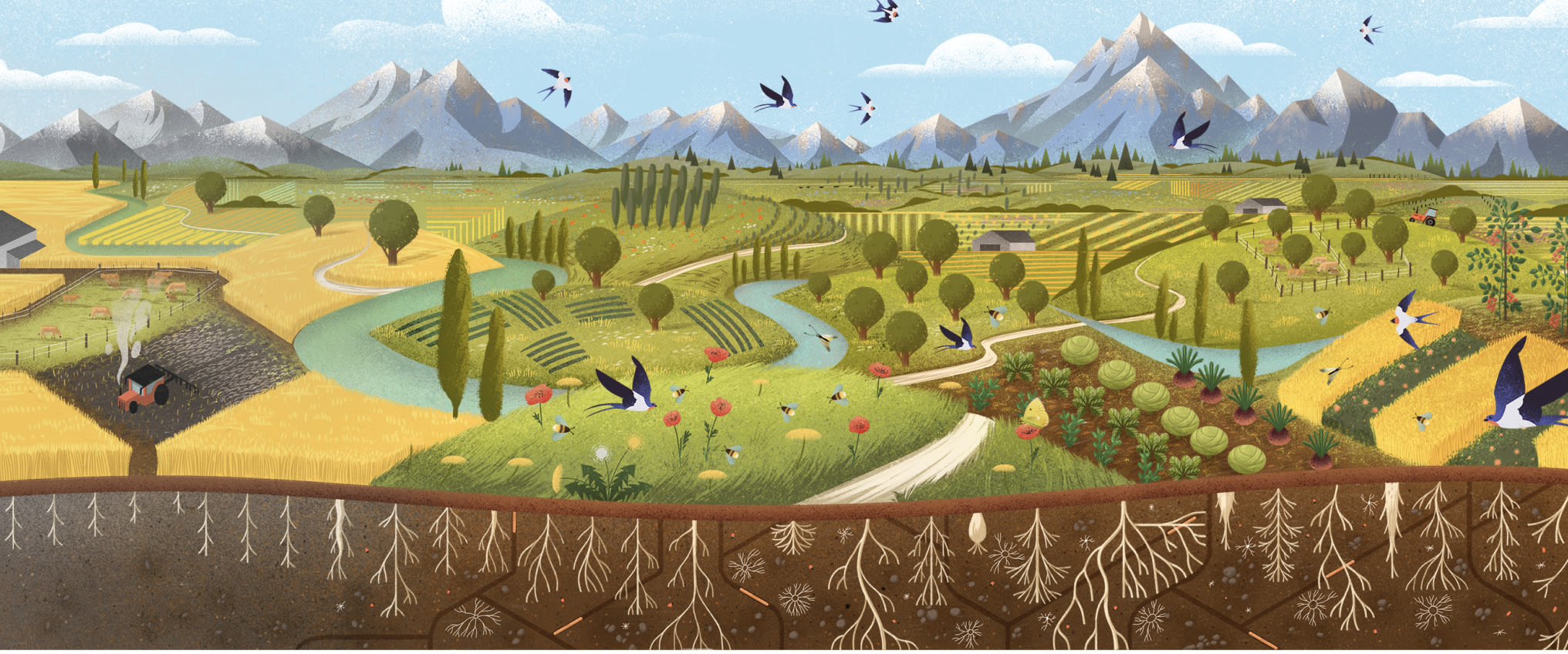
Making nature-positive food the norm
Other available languages
What if food could build biodiversity and tackle climate change?
Fast moving consumer goods companies (FMCGs) and retailers have the power to make nature-positive food that’s good for farmers and business mainstream.
Leading FMCGs and retailers have substantial influence on the food system. In the EU and UK, for example, 40% of agricultural land is influenced by the top 10 FMCGs and retailers. Many of these players are currently part of the problem, but given their size and influence they can be, and need to be, part of the solution.
Rather than bending nature to produce food, food can be designed for nature to thrive
By rethinking the ingredients they use and how they're produced, they can provide choices that are better for customers, better for farmers, and better for the environment.
Today, just four crops provide 60% of the world’s calories, while many ingredients that could be used instead and have a lower impact are rarely used. A nature-positive food system requires a more diverse mix of plants and livestock and a better understanding of local contexts to function effectively.
Major FMCGs and retailers can catalyse this shift in the mix of crops and livestock at scale and pace by creating the demand for diverse ingredients, which most often means fundamentally redesigning their food product portfolios.
To do this, food designers can use the principles of the circular economy and apply them across all dimensions of food design, from product concept, through ingredient selection and sourcing, to packaging . This is circular design for food :
Circular Design for Food Framework

A future food system that's good for people, farmers, nature, and business
The big food redesign , shows that combining four ingredient selection and sourcing opportunities unlocks substantial environmental, economic, and yield benefits. It shows that circular design for food – which involves fundamentally redesigning product portfolios to use all the diverse food outputs of a nature-positive food system – offers significantly greater benefits than using the same ingredients as today, but sourcing them better through regenerative production regenerative production Regenerative production provides food and materials in ways that support positive outcomes for nature, which include but are not limited to: healthy and stable soils, improved local biodiversity, improved air and water quality. .
Circular design for food offers significantly greater benefits than better sourcing alone*
*On average for three modelled ingredients (per harvest for wheat and potatoes, and per year for dairy) in the UK and EU.
FMCGs and retailers can take five actions to bring nature-positive food products into the mainstream
Create ambitious and well-resourced action plans to make nature-positive product portfolios a reality
Create a new collaborative dynamic with farmers
Develop iconic products to showcase the potential of circular design for food
Contribute to and use common on-farm metrics and definitions
Advocate for policies that support a nature-positive food system
A future where nature-positive food available at scale is possible.
Concept foods from a nature-positive future
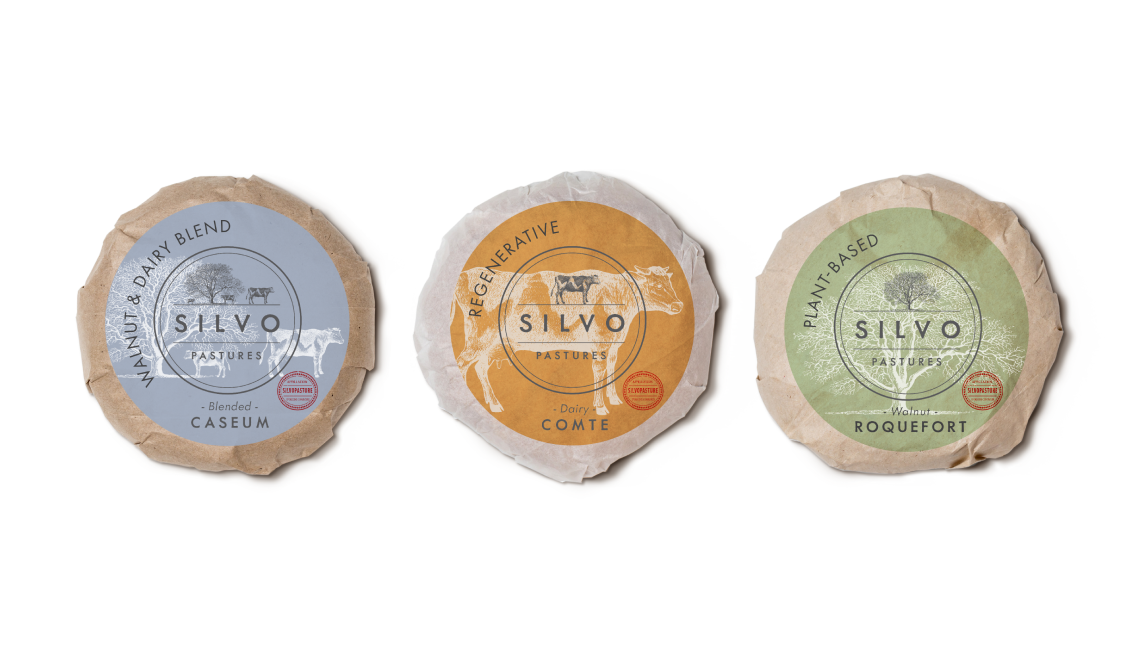
Silvo is on a mission to transform our food system through one of the most delicious foods on the...

Down To Earth
These are not your average potatoes! Down To Earth is a line of super delicious, resilient potato...

Climate Crunch
Start your day right with Regenerate’s Climate Crunch – a delicious, nutrient-dense, protein-packed...

The cookies you love, made from the things you’d never expect. Sweet Up is a line of cookies made...
The big food redesign study
This study looks at the role fast-moving consumer goods companies (FMCGs) and food retailers can play to move us towards a food system with significant positive impacts for business, people, and the environment. It explores the ways in which food products can be designed in closer collaboration with farmers, for nature. It also investigates the crucial enabling role of policies and incentives.
The big food redesign study is available in: English , Español , Português , 中文
The big food redesign: Executive summary is available in: English , Español , Português , 中文
To quote the study, please use the following reference: Ellen MacArthur Foundation, The big food redesign: Regenerating nature with the circular economy (2021).
Supporting material

The big food redesign: Technical appendix
Published in September 2021
The big food redesign: Executive summary

The Big Food Redesign Challenge

What is circular design for food?
To design for positive consumer, economic, farmer, and environmental outcomes, food design can be...

Five actions for companies to make nature-positive food mainstream
FMCGs and retailers can take action in five key areas to make nature-positive food mainstream

Want to stay up to date?
Join our mailing list
Explore all our food material
There are case studies, videos, articles, publications, and more.
News and updates from The Ellen MacArthur Foundation
The Ellen MacArthur Foundation works to accelerate the transition to a circular economy. We develop and promote the idea of a circular economy, and work with business, academia, policymakers, and institutions to mobilise systems solutions at scale, globally.
Charity Registration No.: 1130306
OSCR Registration No.: SC043120
Company No.: 6897785
Ellen MacArthur Foundation ANBI RSIN nummer: 8257 45 925
- Link to EMF LinkedIn page. Opens in a new tab.
- Link to EMF Twitter page. Opens in a new tab.
- Link to EMF YouTube page. Opens in a new tab.
- Link to EMF Instagram page. Opens in a new tab.
- Link to EMF Medium page. Opens in a new tab.
- Link to EMF TikTok page. Opens in a new tab.
- Link to EMF threads page. Opens in a new tab.
The work of the Ellen MacArthur Foundation is supported by our Strategic Partners and Partners.
- Link to EMF Facebook page. Opens in a new tab.

UC Center Sacramento
Uccs spring quarter 2024 undergraduate research showcase, event date wed, jun 5, 2024 @ 11:00am - 1:00pm.
Join us on Wednesday, June 5th for the Undergraduate Research Showcase at UC Center Sacramento (UCCS) from 11:00am - 1:00pm. Meet the Spring 2024 undergraduate student interns and view their public policy research projects completed during their stay in Sacramento. Lunch will be served. Please register by Wednesday, May 29th.
Session A: 11:00am - 12:00pm
Session B: 12:00pm - 1:00pm
To attend in person, please click here.
A no-code swarm simulation framework for agent-based modeling using nature-inspired algorithms
- Original Research
- Published: 13 May 2024
Cite this article

- Ishraq Hasan 1 ,
- Rubyeat Islam 1 ,
- Nusrat Sharmin ORCID: orcid.org/0000-0003-2856-3561 1 &
- Md. Akhtaruzzaman 1
Explore all metrics
Swarm robotics describes the coordination among multiple robots assigned to perform a single task collectively and work as a system. The system is usually used in search and-rescue missions in adverse natural environments. Research in this field involves testing theories and algorithms by using physical robots which requires expensive environment setup. This study presents a novel no-code simulation framework for swarm robotics. The software framework provides a set of building block of various components to customize the research and development process. Besides the various platforms that exist nowadays, this proposed framework overcomes the common problem of low flexibility in modeling, resulting significant improvements in the development of any simulation through customization of algorithms and multi-agent modeling. For rapid development of simulation instances, this study proposes a swarm simulation framework that allows multi-agent modeling in a no-code development environment by defining the number of agents and the behaviors they are expected to exhibit. A random environment is generated where the agents and specific target is defined to test swarm robots for search and rescue operations. The framework mainly proposes a no-code environment and provides the opportunity to test the swarm behavior and relevant theories with flexibilities to make necessary adjustments.
This is a preview of subscription content, log in via an institution to check access.
Access this article
Price includes VAT (Russian Federation)
Instant access to the full article PDF.
Rent this article via DeepDyve
Institutional subscriptions
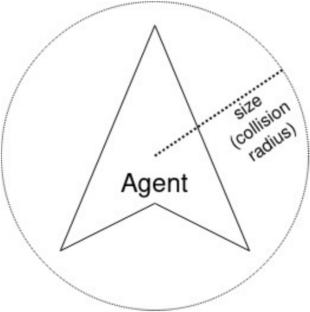
Data availability
Not applicable.
A toolkit featured under ‘Unity’, that developers can use to construct elaborate projects with limited or no coding efforts.
Beni G, Wang J (1993) Swarm intelligence in cellular robotic systems. In: Ddd V (ed) Robots and biological systems: towards a new bionics? Springer, Berlin, pp 703–712
Chapter Google Scholar
Choutri K, Lagha M, Dala L (2021) A fully autonomous search and rescue system using quadrotor UAV. Int J Comput Digit Syst 10:2–12
Google Scholar
de Alcantara Andrade FA, ReinierHovenburg A, Netto de Lima L, Dahlin Rodin C, Johansen TA, Storvold R, MoraesCorreia CA, Barreto Haddad D (2019) Autonomous unmanned aerial vehicles in search and rescue missions using real-time cooperative model predictive control. Sensors 19(19):4067
Article Google Scholar
Gerkey B, Vaughan RT, Howard A et al (2003) The player/stage project: tools for multi-robot and distributed sensor systems. In: Proceedings of the 11th international conference on advanced robotics, vol 1. Citeseer, pp 317–323
Koenig N, Howard A (2004) Design and use paradigms for Gazebo, an opensource multi-robot simulator. In: 2004 IEEE/rsj international conference on intelligent robots and systems (IROS) (IEEE Cat. No. 04CH37566), vol 3. IEEE, pp 2149–2154
Le B-S, Dang V-L, Bui T-T Swarm robotics simulation using unity. Faculty of Electronics and Telecommunications, University of Science, VNU-HCM, Vietnam
Alfeo AL, Cimino MG, De Francesco N, Lega M, Vaglini G (2018) Design and simulation of the emergent behavior of small drones swarming for distributed target localization. J Comput Sci 29:19–33
Pinciroli C, Trianni V, O’Grady R, Pini G, Brutschy A, Brambilla M, Mathews N, Ferrante E, Di Caro G, Ducatelle F et al (2012) Argos: a modular, parallel, multi-engine simulator for multi-robot systems. Swarm Intell 6(4):271–295
Venkatasivarambabu P, Agrawal R (2024) Enhancing UAV navigation with dynamic programming and hybrid probabilistic route mapping: an improved dynamic window approach. Int J Inf Technol 16(2):1023–1032
Singha AK, Zubair S (2024) Combination of optimization methods in a multi stage approach for a deep neural network model. Int J Inf Technol 16(3):1855–1861
Grasso P, Innocente MS (2022) Stigmergy-based collision–avoidance algorithm for self-organising swarms. In: Computational vision and bio-inspired computing: proceedings of ICCVBIC 2021. Springer, pp 253–261
Arora G, Chauhan P, Emadifar H, Khademi M (2023) Numerical simulation of burger’s equation using a particle swarm optimization. Int J Inf Technol 1–8
Raghav YY, Vyas V (2023) Acbso: a hybrid solution for load balancing using ant colony and bird swarm optimization algorithms. Int J Inf Technol 15(5):2847–2857
Agarwal S, Muppalaneni NB (2022) Portfolio optimization in stocks using mean–variance optimization and the efficient frontier. Int J Inf Technol 14(6):2917–2926
Download references
Author information
Authors and affiliations.
Department of Computer Science and Engineering, Military Institute of Science and Technology, Dhaka, Bangladesh
Ishraq Hasan, Rubyeat Islam, Nusrat Sharmin & Md. Akhtaruzzaman
You can also search for this author in PubMed Google Scholar
Corresponding author
Correspondence to Nusrat Sharmin .
Rights and permissions
Springer Nature or its licensor (e.g. a society or other partner) holds exclusive rights to this article under a publishing agreement with the author(s) or other rightsholder(s); author self-archiving of the accepted manuscript version of this article is solely governed by the terms of such publishing agreement and applicable law.
Reprints and permissions
About this article
Hasan, I., Islam, R., Sharmin, N. et al. A no-code swarm simulation framework for agent-based modeling using nature-inspired algorithms. Int. j. inf. tecnol. (2024). https://doi.org/10.1007/s41870-024-01910-1
Download citation
Received : 21 December 2023
Accepted : 23 April 2024
Published : 13 May 2024
DOI : https://doi.org/10.1007/s41870-024-01910-1
Share this article
Anyone you share the following link with will be able to read this content:
Sorry, a shareable link is not currently available for this article.
Provided by the Springer Nature SharedIt content-sharing initiative
- Swarm robotics
- Simulation framework
- Multi-agent modeling
- No-code environment
- Find a journal
- Publish with us
- Track your research

IMAGES
VIDEO
COMMENTS
A theoretical framework guides the research process like a roadmap for the study, so you need to get this right. Theoretical framework 1,2 is the structure that supports and describes a theory. A theory is a set of interrelated concepts and definitions that present a systematic view of phenomena by describing the relationship among the variables for explaining these phenomena.
Developing a conceptual framework in research. Step 1: Choose your research question. Step 2: Select your independent and dependent variables. Step 3: Visualize your cause-and-effect relationship. Step 4: Identify other influencing variables. Frequently asked questions about conceptual models.
A conceptual framework in research is not just a tool but a vital roadmap that guides the entire research process. It integrates various theories, assumptions, and beliefs to provide a structured approach to research. By defining a conceptual framework, researchers can focus their inquiries and clarify their hypotheses, leading to more ...
A conceptual framework is a structured approach to organizing and understanding complex ideas, theories, or concepts. It provides a systematic and coherent way of thinking about a problem or topic, and helps to guide research or analysis in a particular field. A conceptual framework typically includes a set of assumptions, concepts, and ...
Steps to Developing the Perfect Conceptual Framework. Pick a question. Conduct a literature review. Identify your variables. Create your conceptual framework. 1. Pick a Question. You should already have some idea of the broad area of your research project. Try to narrow down your research field to a manageable topic in terms of time and resources.
A theoretical framework is a foundational review of existing theories that serves as a roadmap for developing the arguments you will use in your own work. Theories are developed by researchers to explain phenomena, draw connections, and make predictions. In a theoretical framework, you explain the existing theories that support your research ...
A conceptual framework illustrates the expected relationship between your variables. It defines the relevant objectives for your research process and maps out how they come together to draw coherent conclusions. Tip. You should construct your conceptual framework before you begin collecting your data.
To learn more about the definition and goal of a theoretical framework, check out our step-by-step guide to writing a theoretical framework. Other interesting articles If you want to know more about AI for academic writing, AI tools, or research bias, make sure to check out some of our other articles with explanations and examples or go ...
Building your framework will occur in phases and proceed through cycles of clarifying your questions, making more precise and explicit your predictions, articulating reasons for making these predictions, and imagining ways of testing the predictions. The major source for ideas that will shape the framework is the research literature.
A theoretical framework is a foundational review of existing theories that serves as a roadmap for developing the arguments you will use in your own work. Theories are developed by researchers to explain phenomena, draw connections, and make predictions. In a theoretical framework, you explain the existing theories that support your research ...
The conceptual framework helps you cultivate research questions and then match . the methodological aspects of the study with these questions. In this sense, the con-ceptual framework helps align the analytic tools and methods of a study with the focal topics and . core constructs. as they are embedded within the research questions. This
Writing a conceptual framework involves several steps to develop a logical and structured foundation for your dissertation. Discover our step-by-step guide. Step 1. Identification of the research problem. The initial step entails pinpointing the research issue the work intends to address.
A conceptual framework helps researchers create a clear research goal. Research projects often become vague and lose their focus, which makes them less useful. However, a well-designed conceptual framework helps researchers maintain focus. It reinforces the project's scope, ensuring it stays on track and produces meaningful results.
First, click the Insert tab and select Shapes. You'll see a wide range of shapes to choose from. Usually, rectangles, circles, and arrows are the shapes used for the conceptual framework. Next, draw your selected shape in the document. Insert the name of the variable inside the shape.
A conceptual framework illustrates what you expect to find through your research. It defines the relevant variables for your study and maps out how they migh...
The theoretical framework is the structure that can hold or support a theory of a research study. The theoretical framework encompasses not just the theory, but the narrative explanation about how the researcher engages in using the theory and its underlying assumptions to investigate the research problem.
Theoretical Framework. Definition: Theoretical framework refers to a set of concepts, theories, ideas, and assumptions that serve as a foundation for understanding a particular phenomenon or problem. It provides a conceptual framework that helps researchers to design and conduct their research, as well as to analyze and interpret their findings.
4 Steps on How to Make the Conceptual Framework. Choose your topic. Do a literature review. Isolate the important variables. Generate the conceptual framework. Example of a Conceptual Framework. Research Topic. Thesis Statement. Review of Literature.
Helps the researcher organize ideas and clarify concepts. Introduces your research and how it will advance your field of practice. A conceptual framework should include concepts applicable to the field of study. These can be in the field or neighboring fields - as long as important details are captured and the framework is relevant to the ...
Here's how to create a theoretical framework for your study or research paper in four steps: 1. Define your objective. The first step in creating a theoretical framework is to define your research objective and then gather supporting documents. Consider what you hope to achieve with your study and what new information you aim to bring to your ...
Before you prepare your conceptual framework, you need to do the following things: 1. Choose your topic. As a researcher, you have the option of focusing on a wide range of topics. However, we must remember that not all of the world's resources are available to us. The research could also be time-limited.
The term conceptual framework and theoretical framework are often and erroneously used interchangeably (Grant & Osanloo, 2014). A theoretical framework provides the theoretical assumptions for the larger context of a study, and is the foundation or 'lens' by which a study is developed. This framework helps to ground the research focus ...
The mission of NIH is to seek fundamental knowledge about the nature and behavior of living systems and to apply that knowledge to enhance health, lengthen life, and reduce illness and disability.In support of this mission, Research Project Grant (RPG) applications to support biomedical and behavioral research are evaluated for scientific and technical merit through the NIH peer review system.
Tenets from the Collaborative for Academic, Social, and Emotional Learning (CASEL) were submitted through the four-step protocol. Findings suggest that CASEL is a valuable framework when applied authentically and that ICP is a constructive tool for engaging in the social sciences with integrity.
The exponential growth of network intrusions necessitates the development of advanced artificial intelligence (AI) techniques for intrusion detection systems (IDSs). However, the reliance on AI for IDSs presents several challenges, including the performance variability of different AI models and the opacity of their decision-making processes, hindering comprehension by human security analysts ...
Digital twins represent a promising approach for sustainable building operations and management in the context of the carbon neutrality goals of the European Union (EU). Using OpenStudio, an opensource platform for building energy modeling, we demonstrated the creation and editing of building digital twins. OpenStudio provides a user-friendly interface and extensive simulation capabilities ...
FMCGs and retailers design what we eat - how it looks, how it tastes, and how good it is for us and for nature. Combining the principles of circular economy circular economy A systems solution framework that tackles global challenges like climate change, biodiversity loss, waste, and pollution. It is based on three principles, driven by design: eliminate waste and pollution, circulate ...
Join us on Wednesday, June 5th for the Undergraduate Research Showcase at UC Center Sacramento (UCCS) from 11:00am - 1:00pm. Meet the Spring 2024 undergraduate student interns and view their public policy research projects completed during their stay in Sacramento. ... "A Map-Based Decision-making Framework for Equity in EV Charging" May 15 ...
Research in this field involves testing theories and algorithms by using physical robots which requires expensive environment setup. This study presents a novel no-code simulation framework for swarm robotics. The software framework provides a set of building block of various components to customize the research and development process.